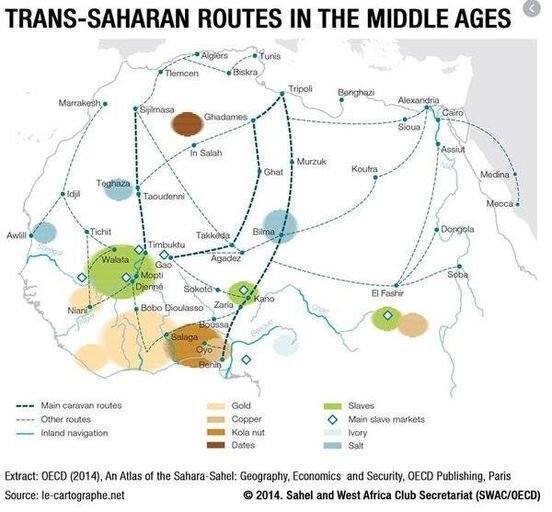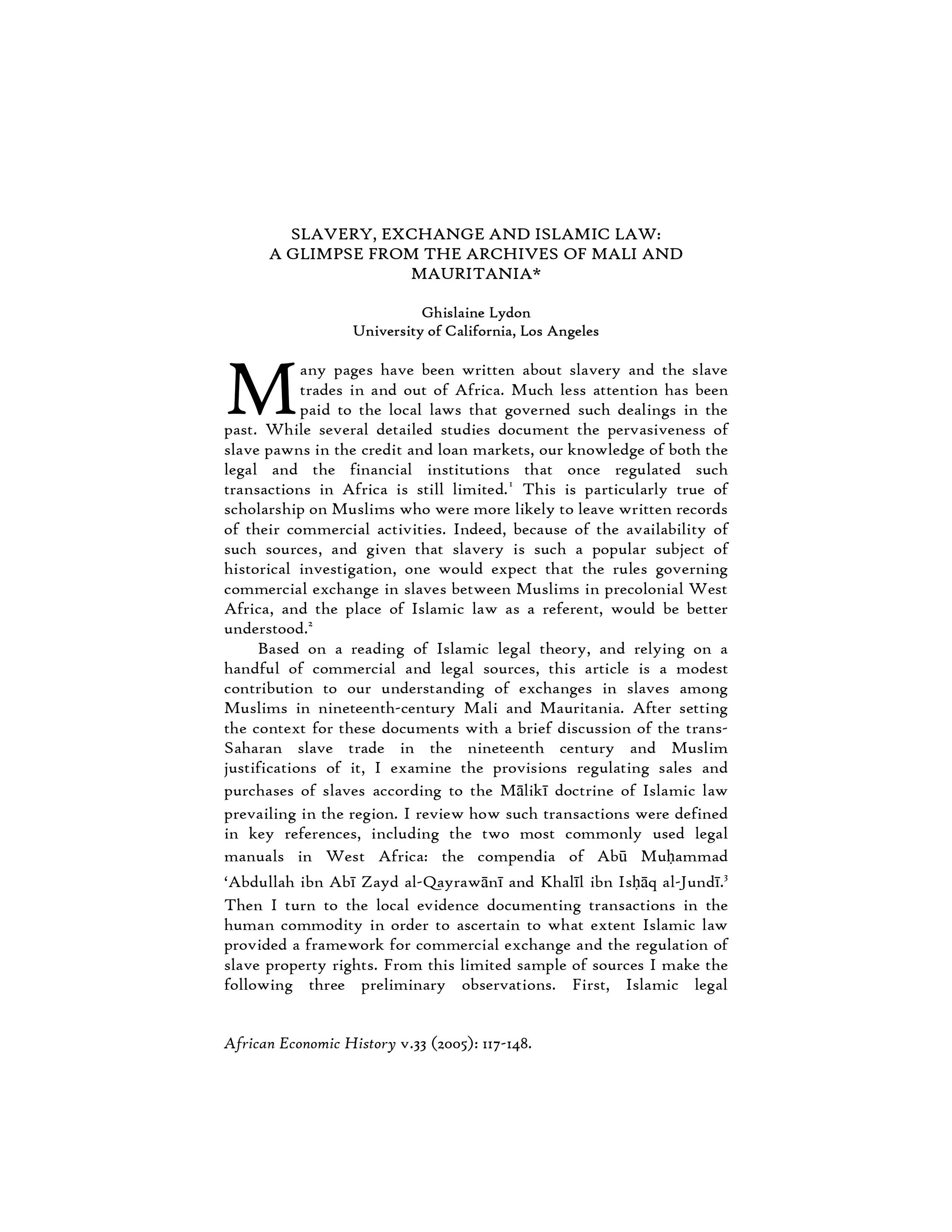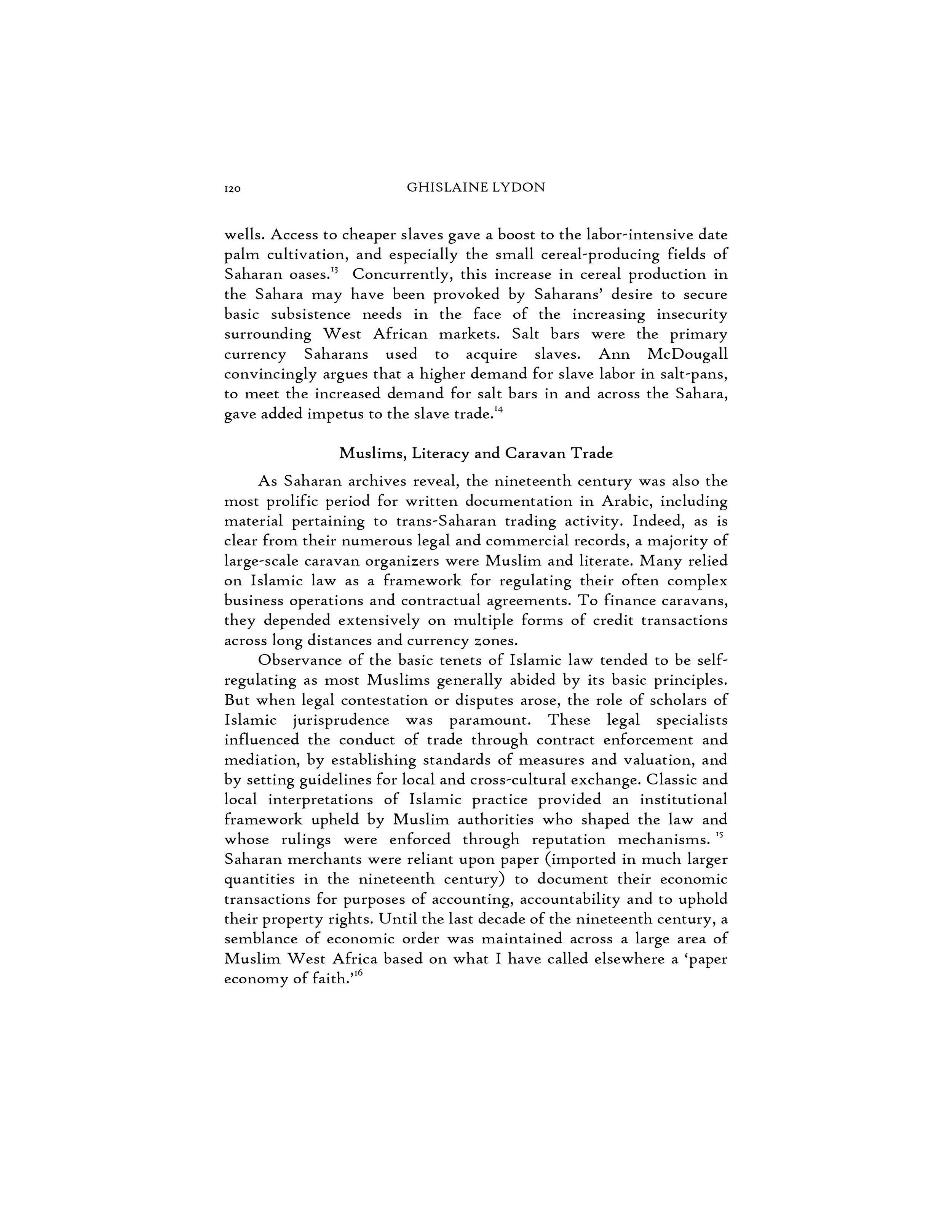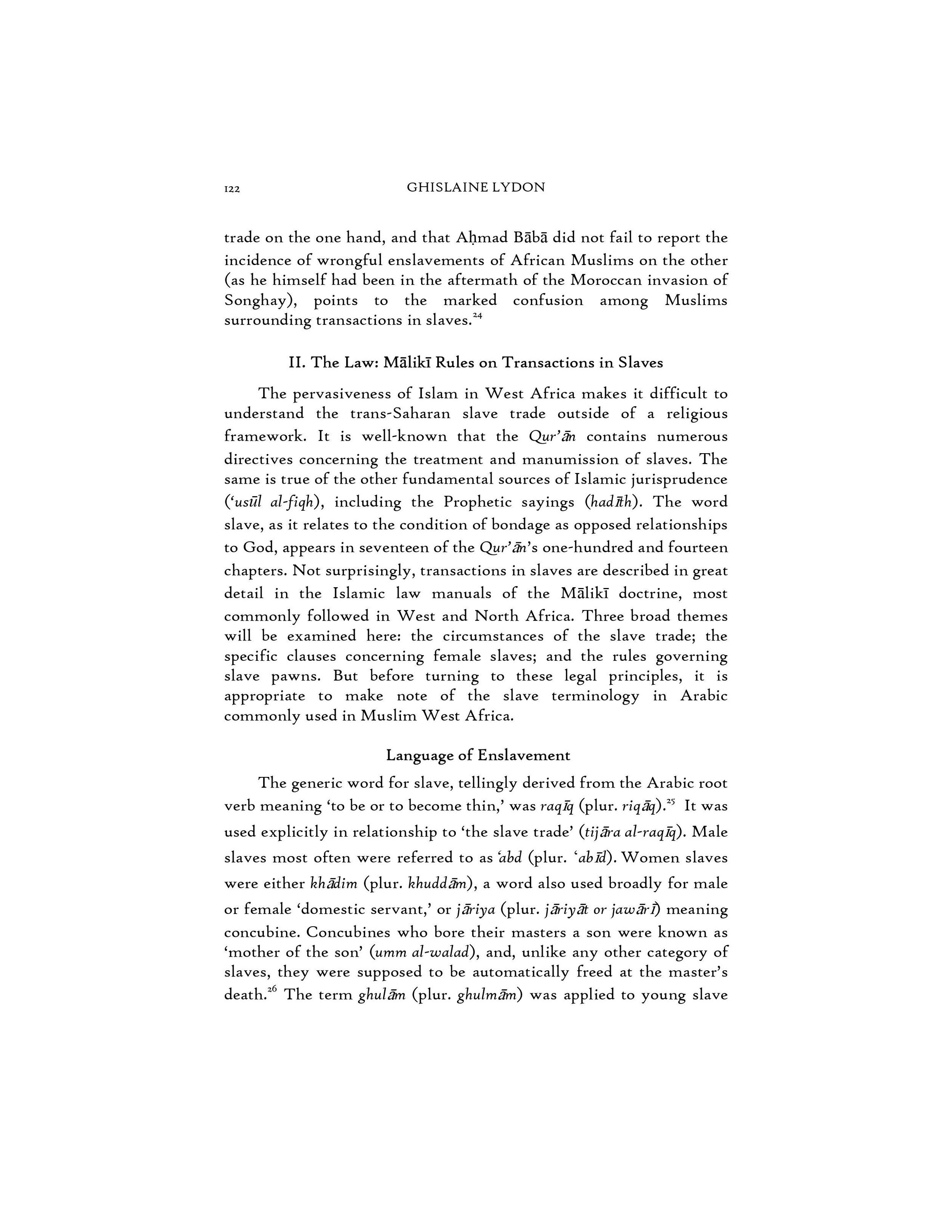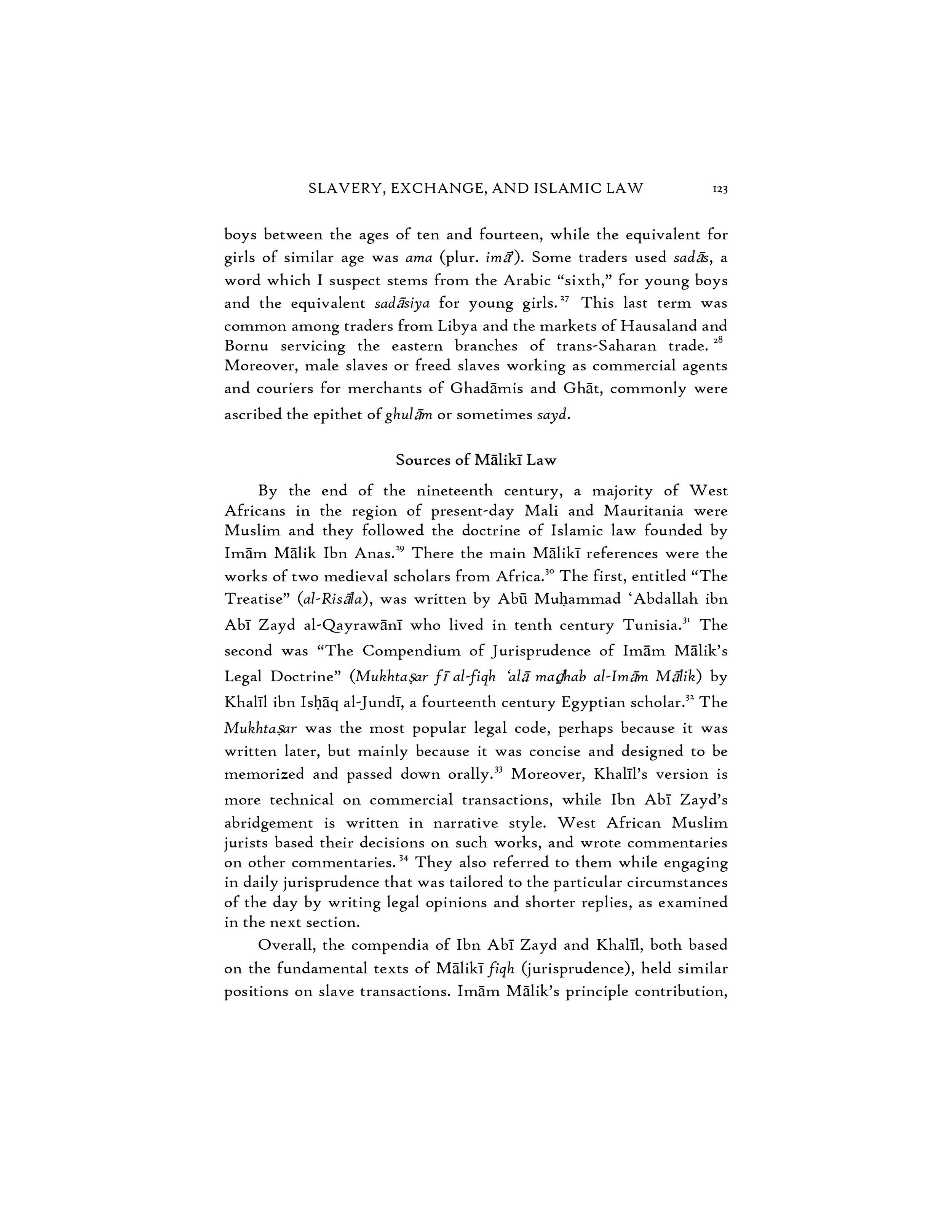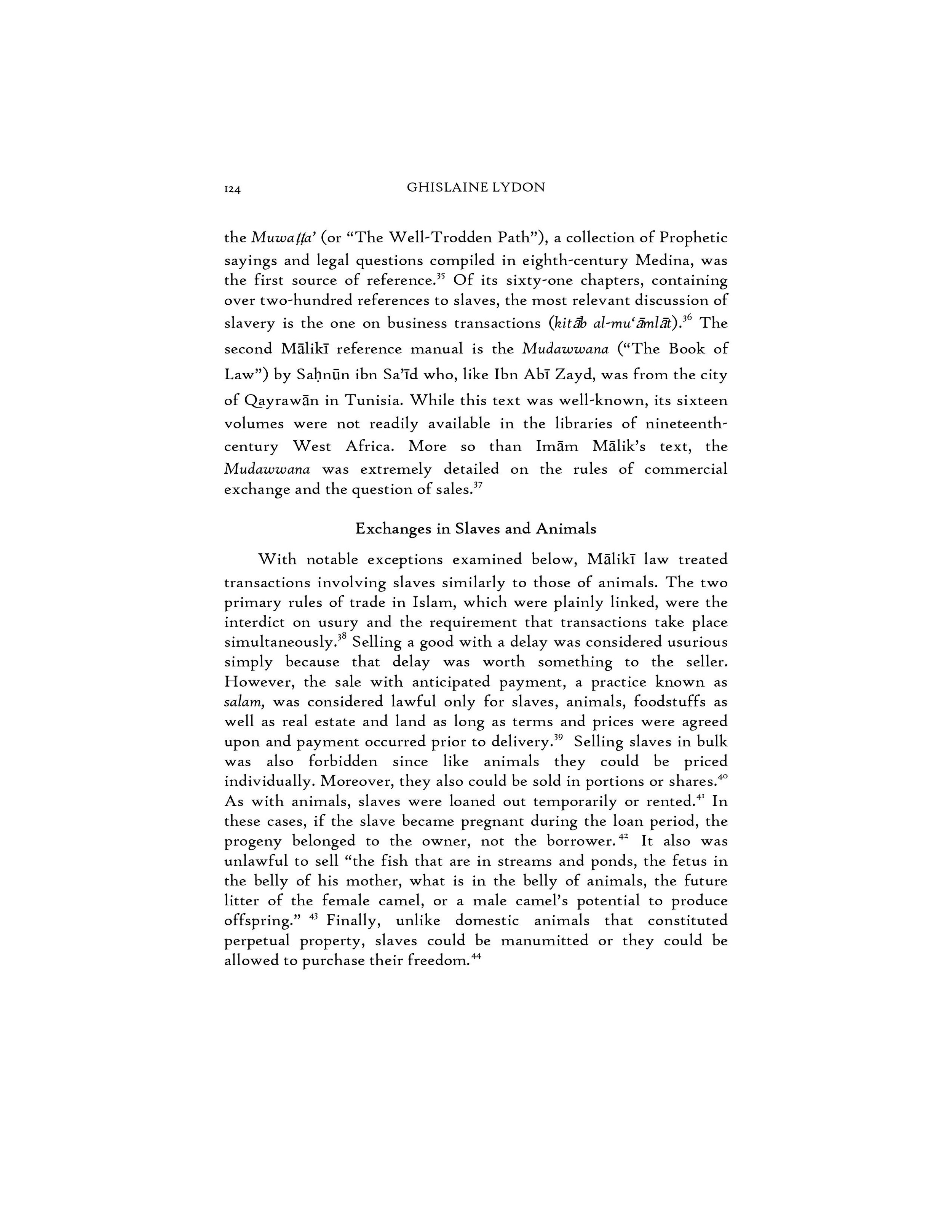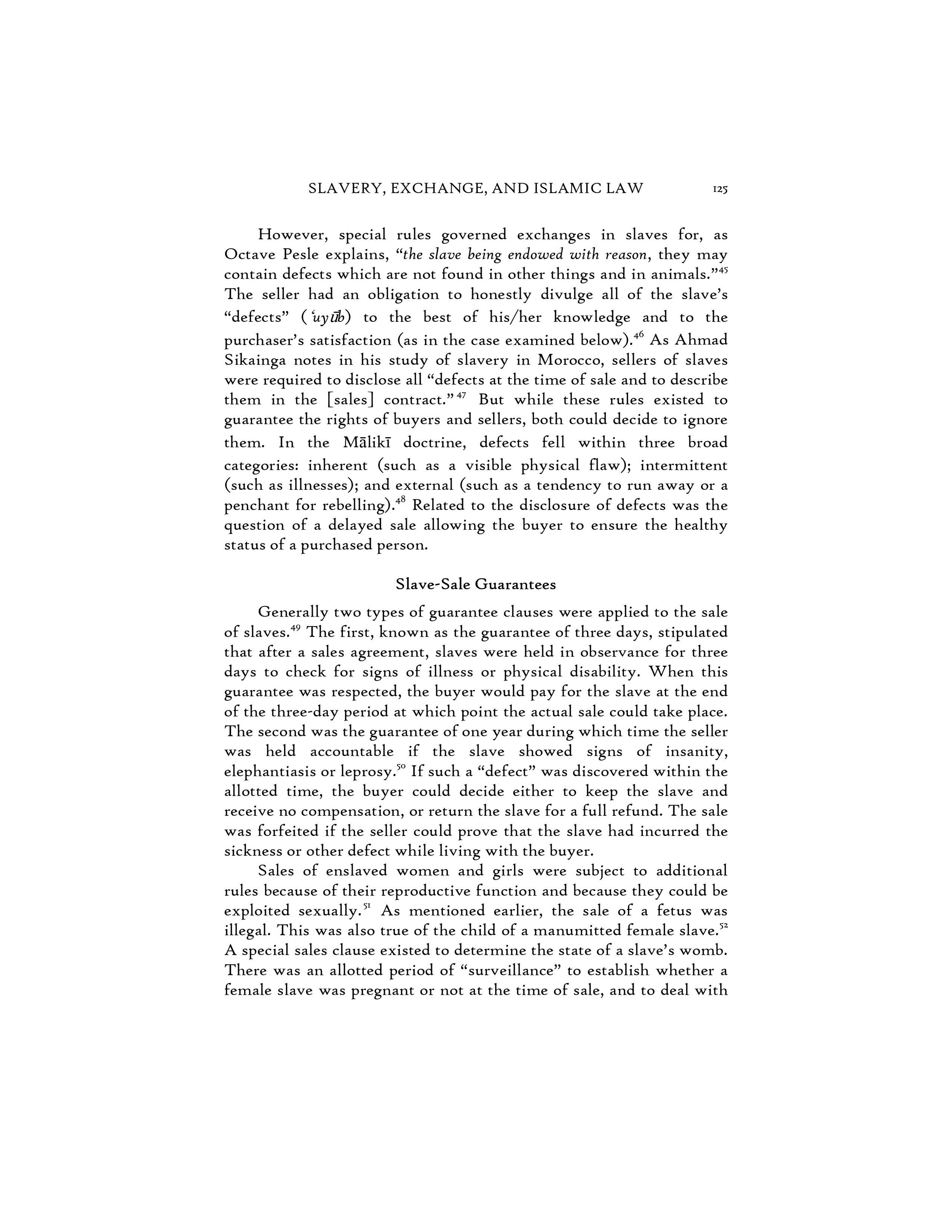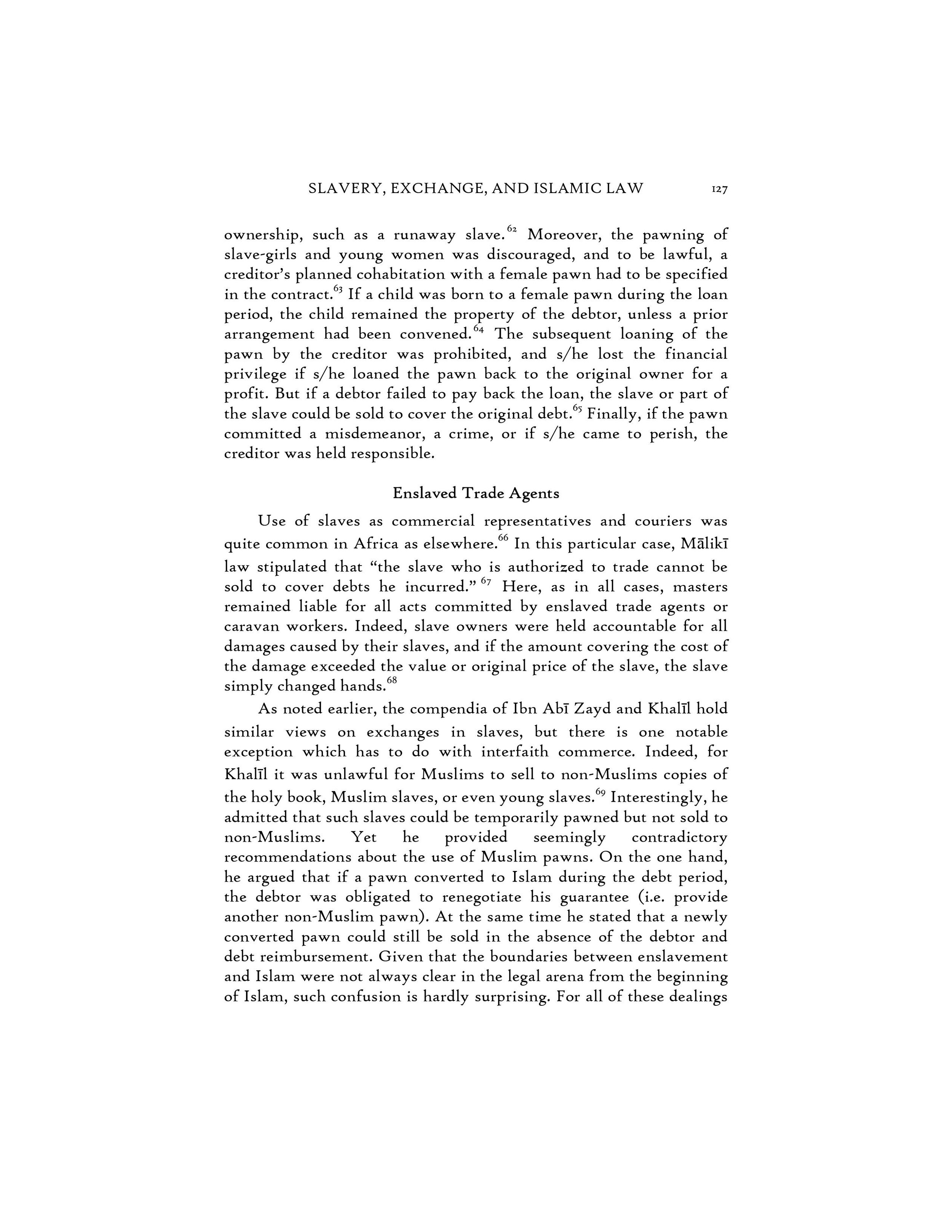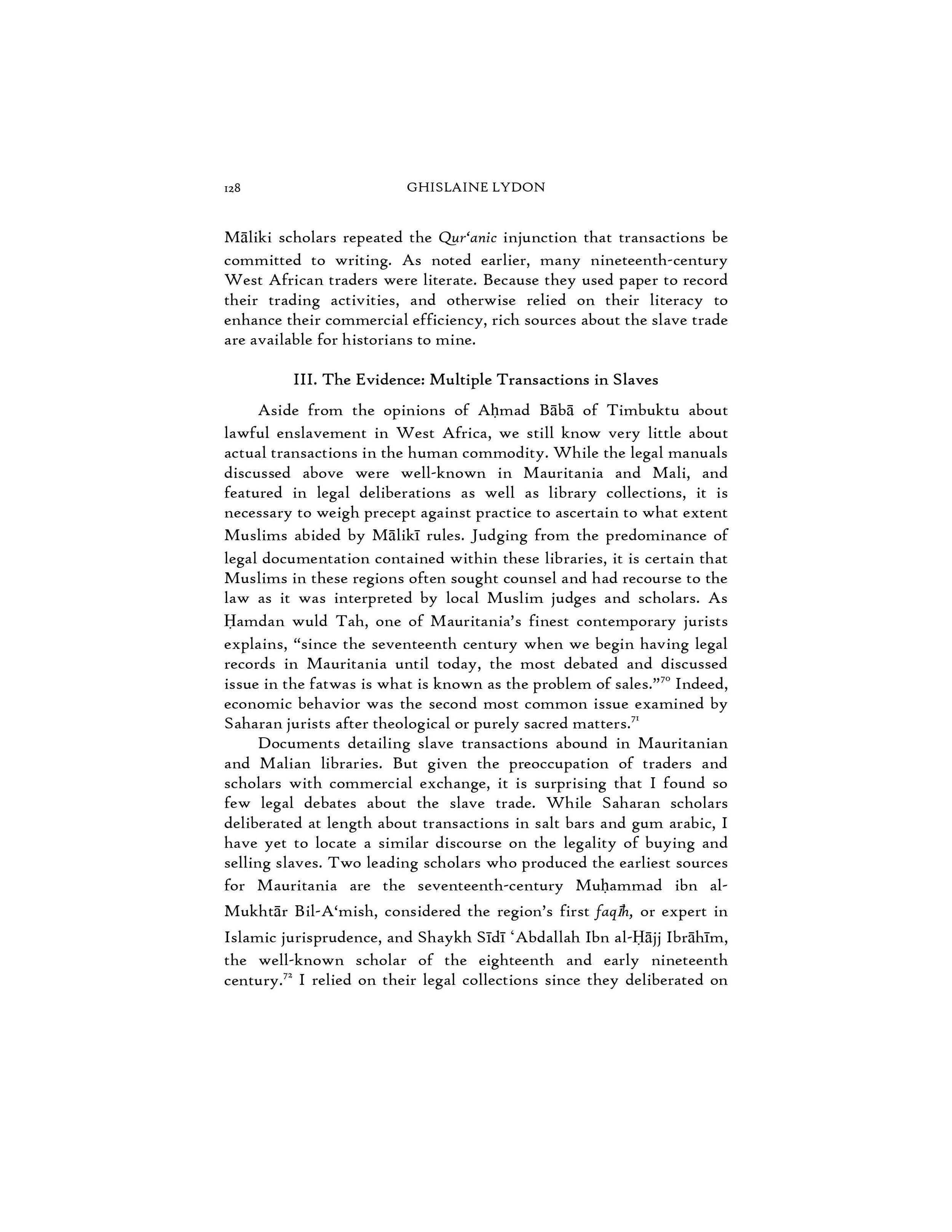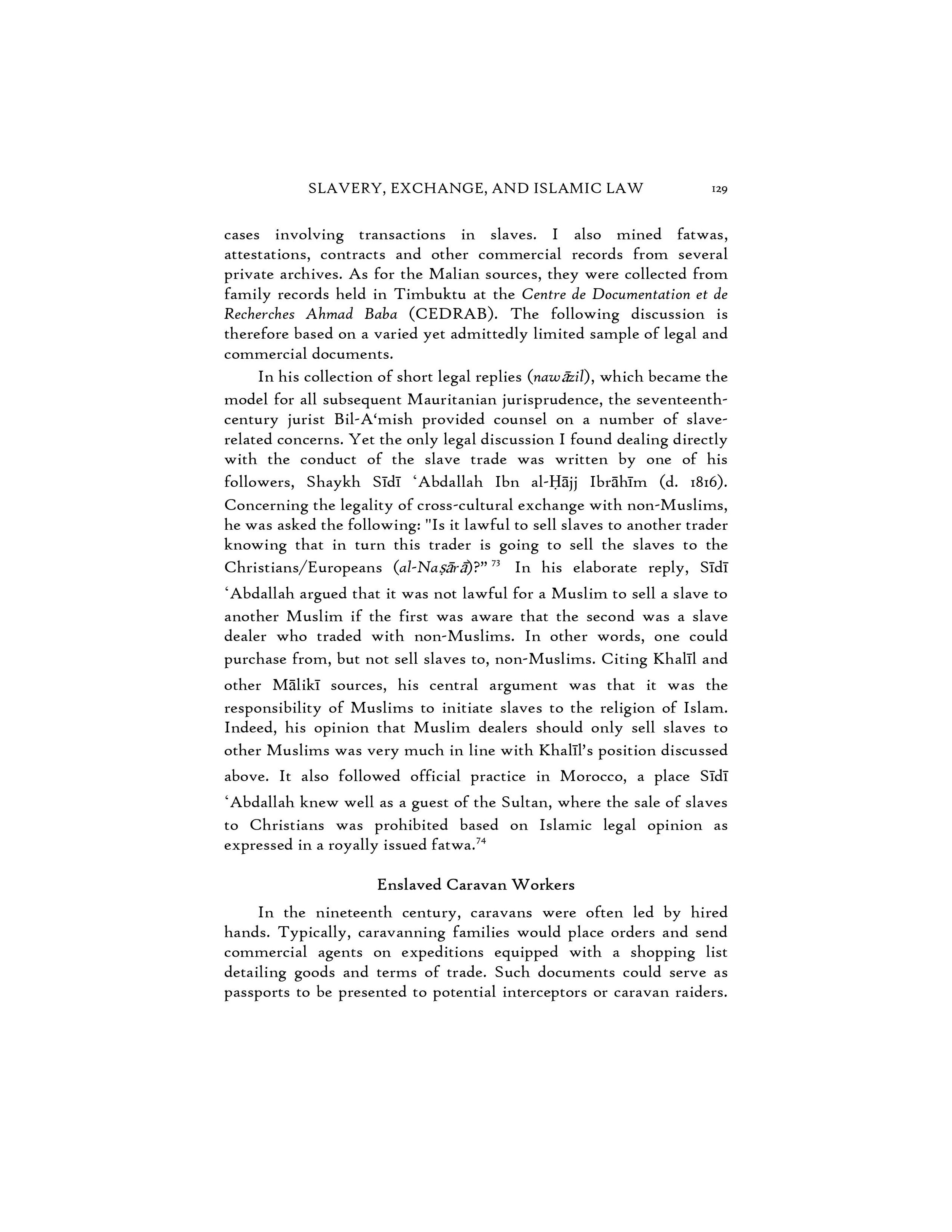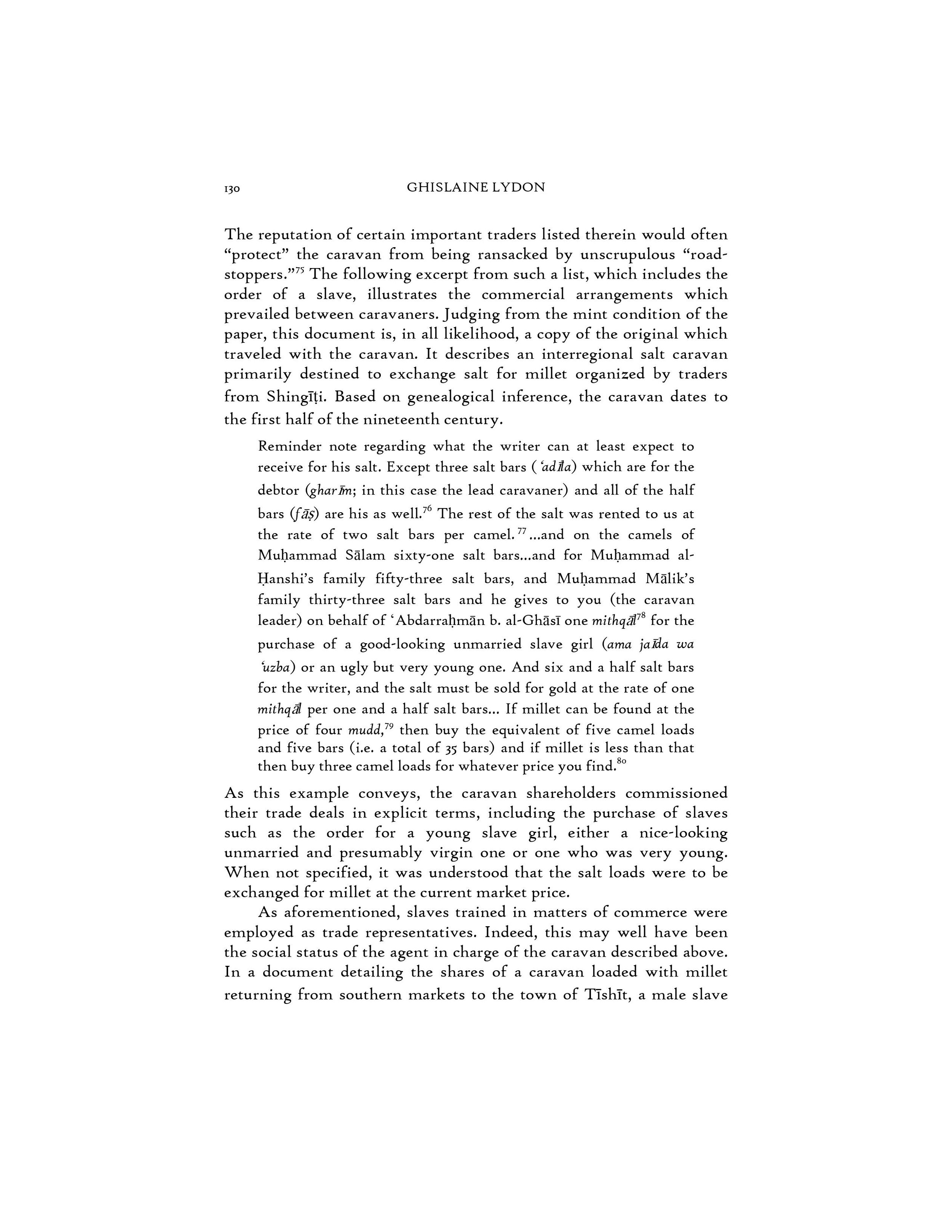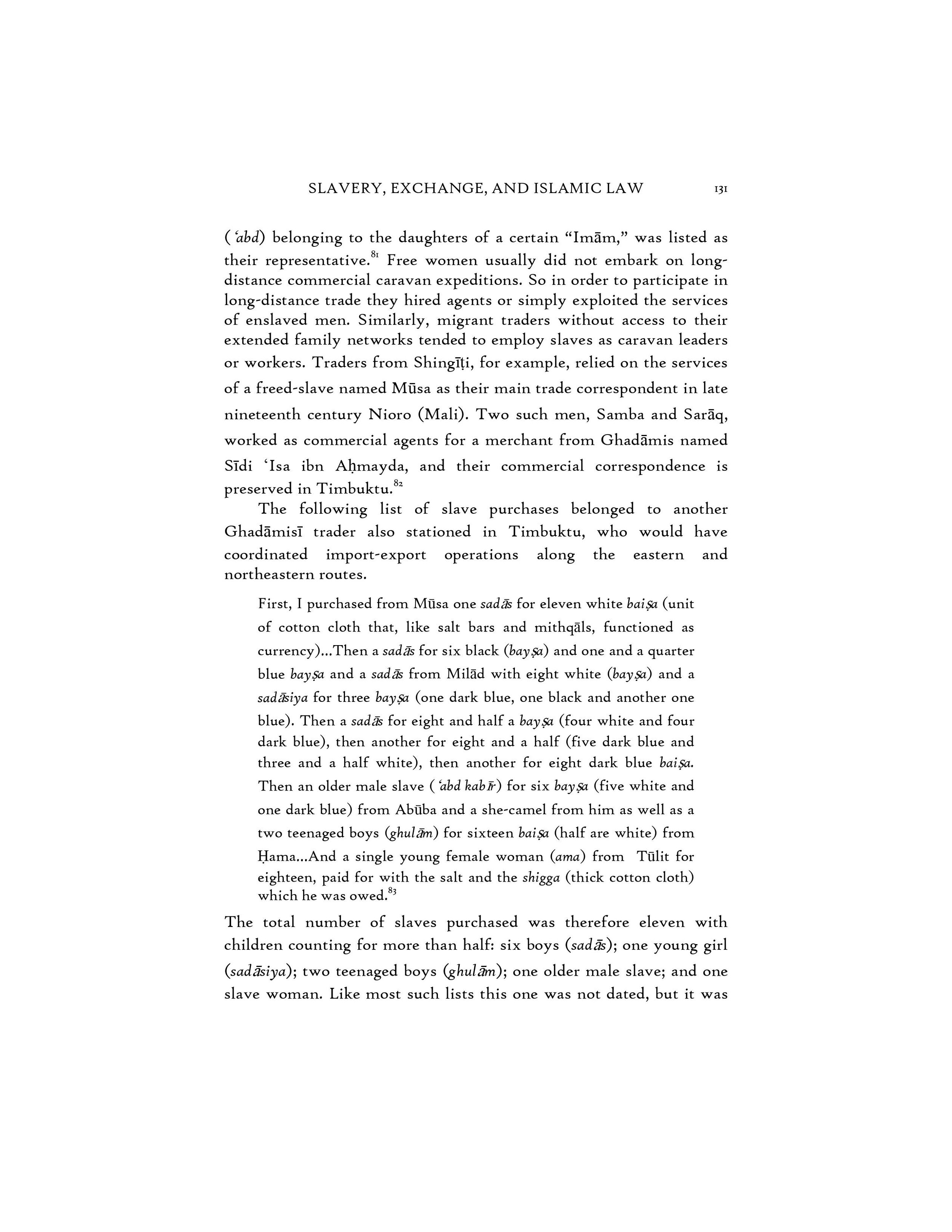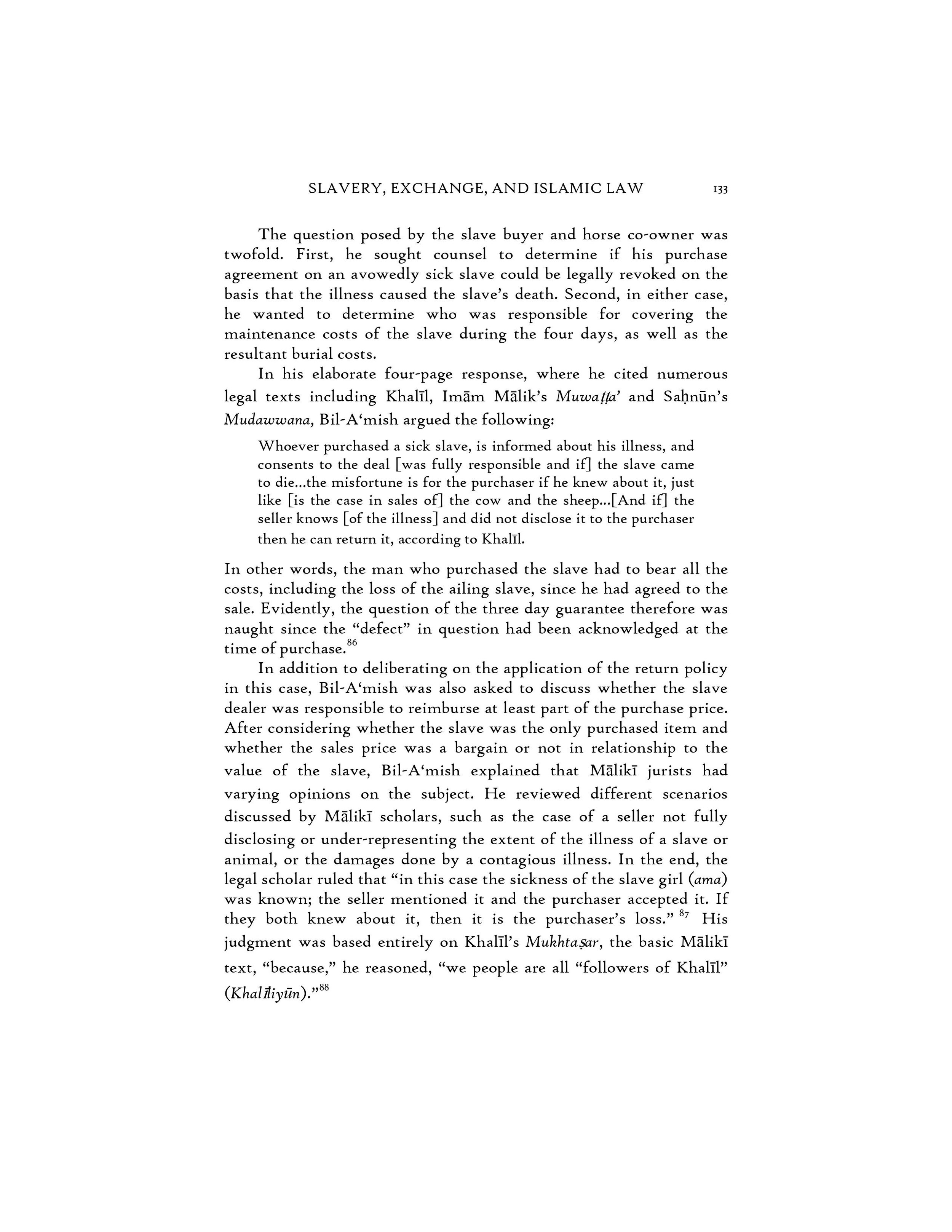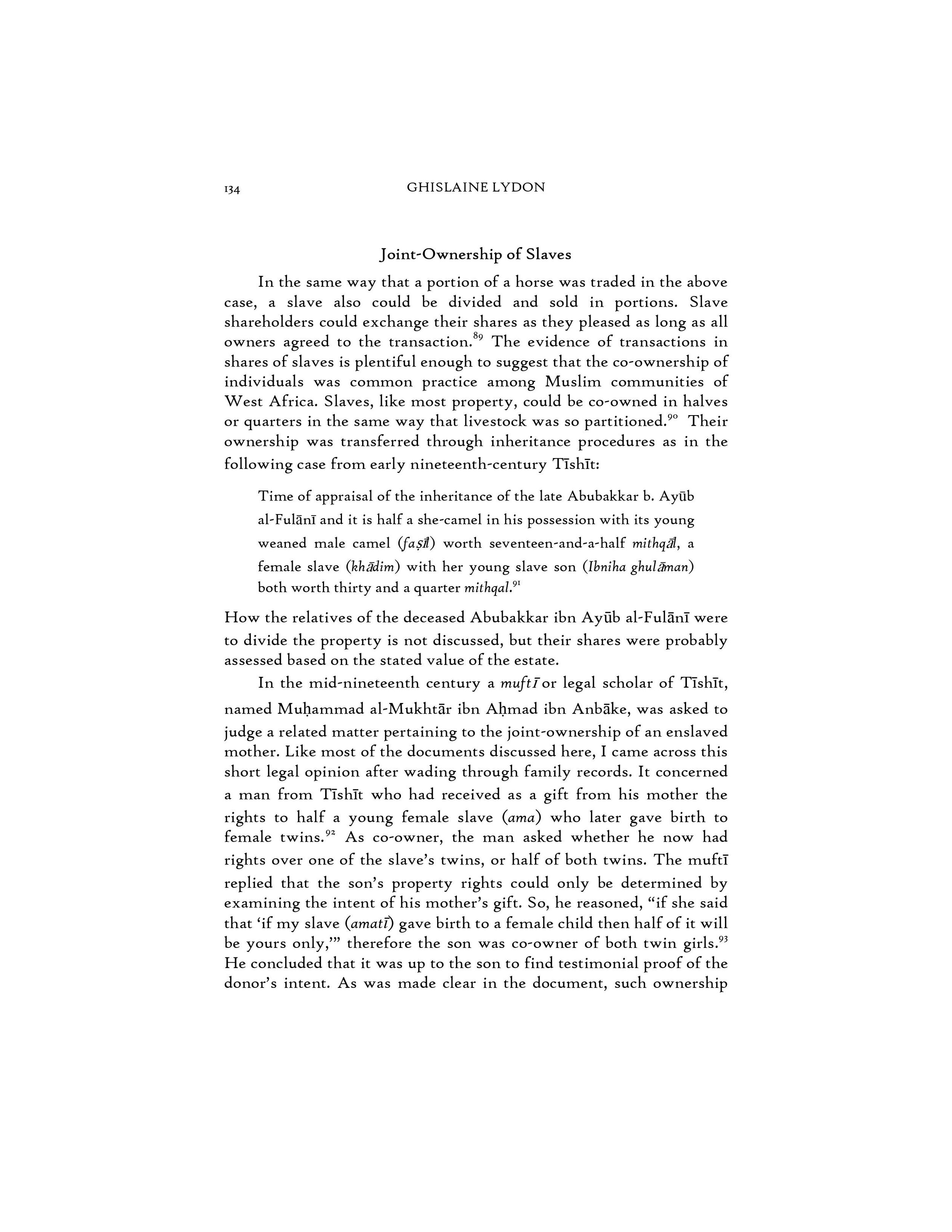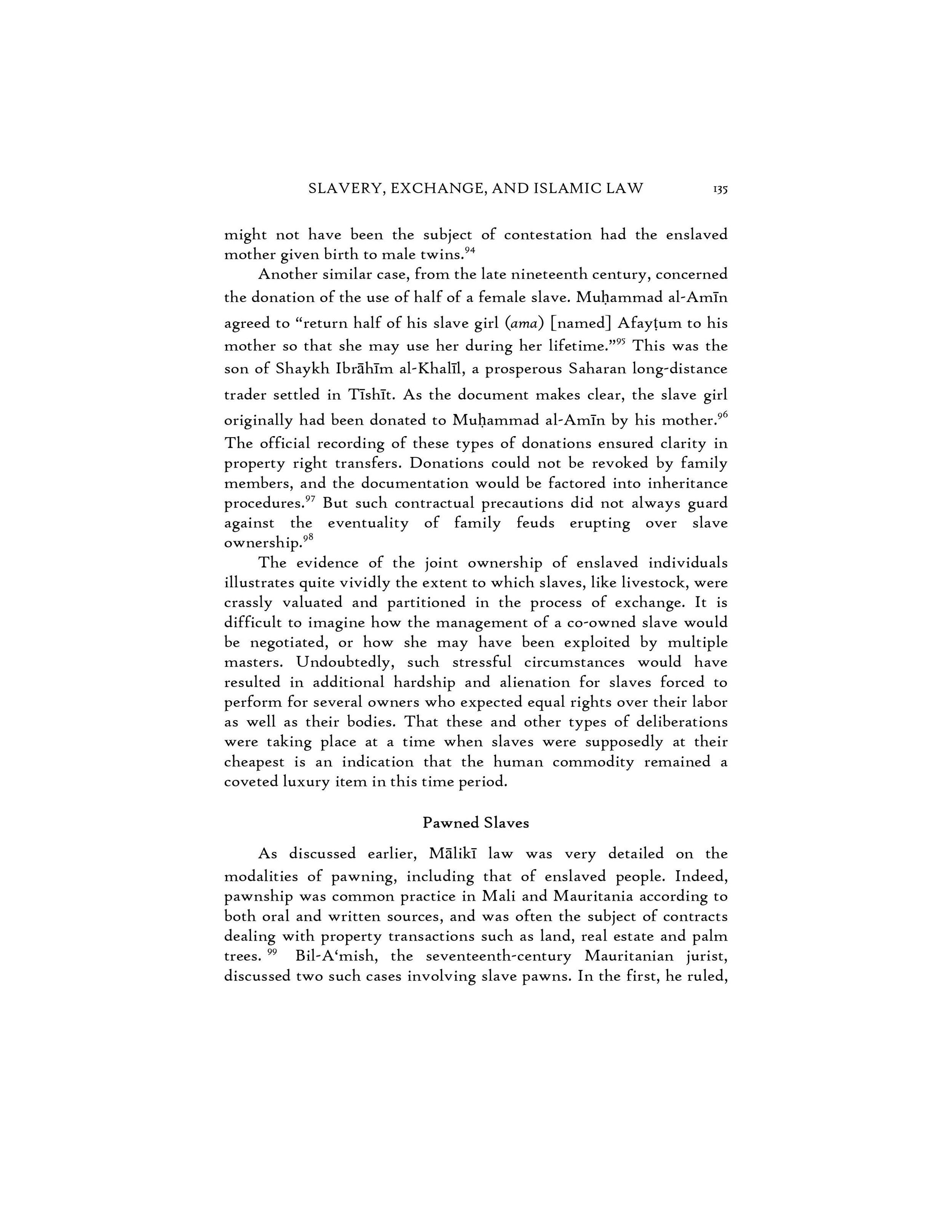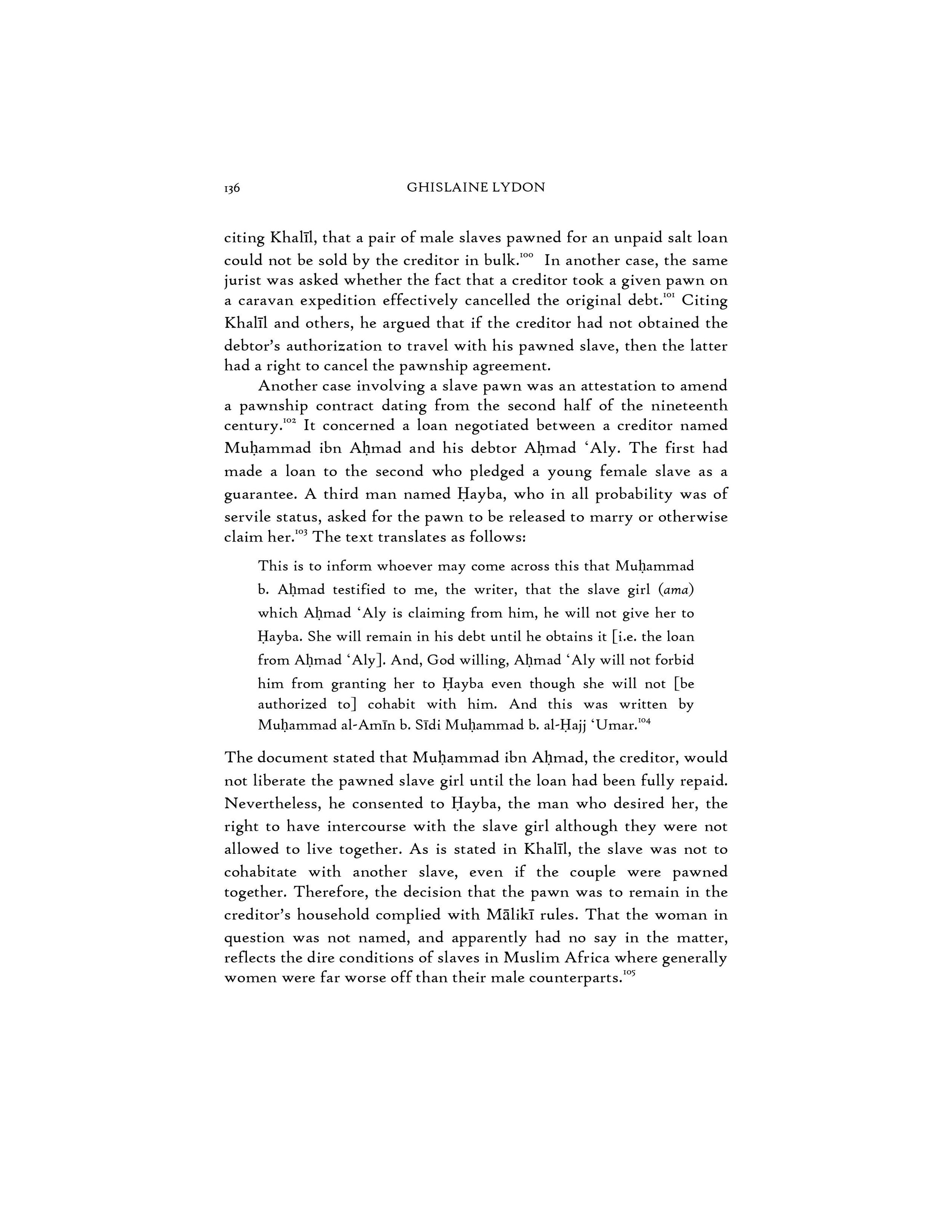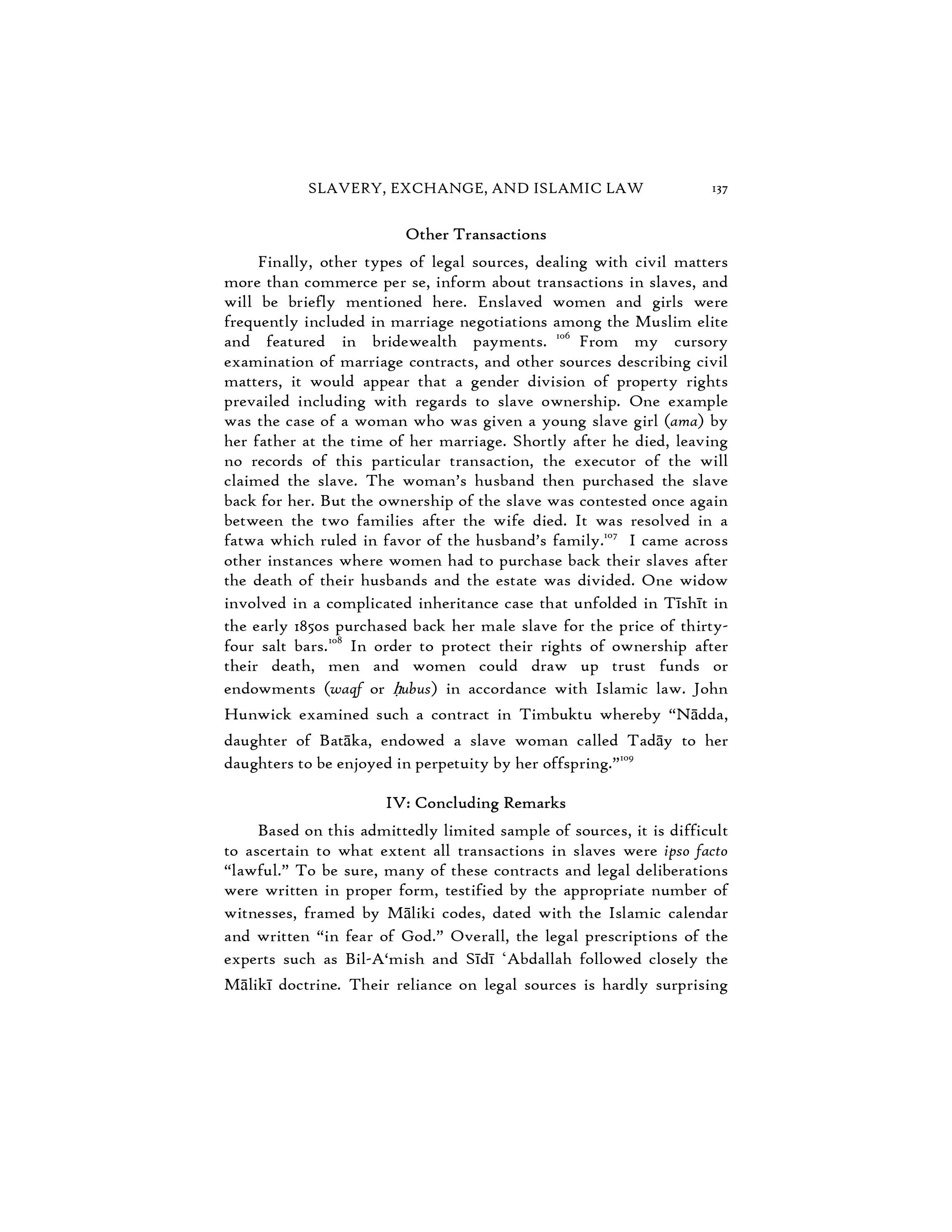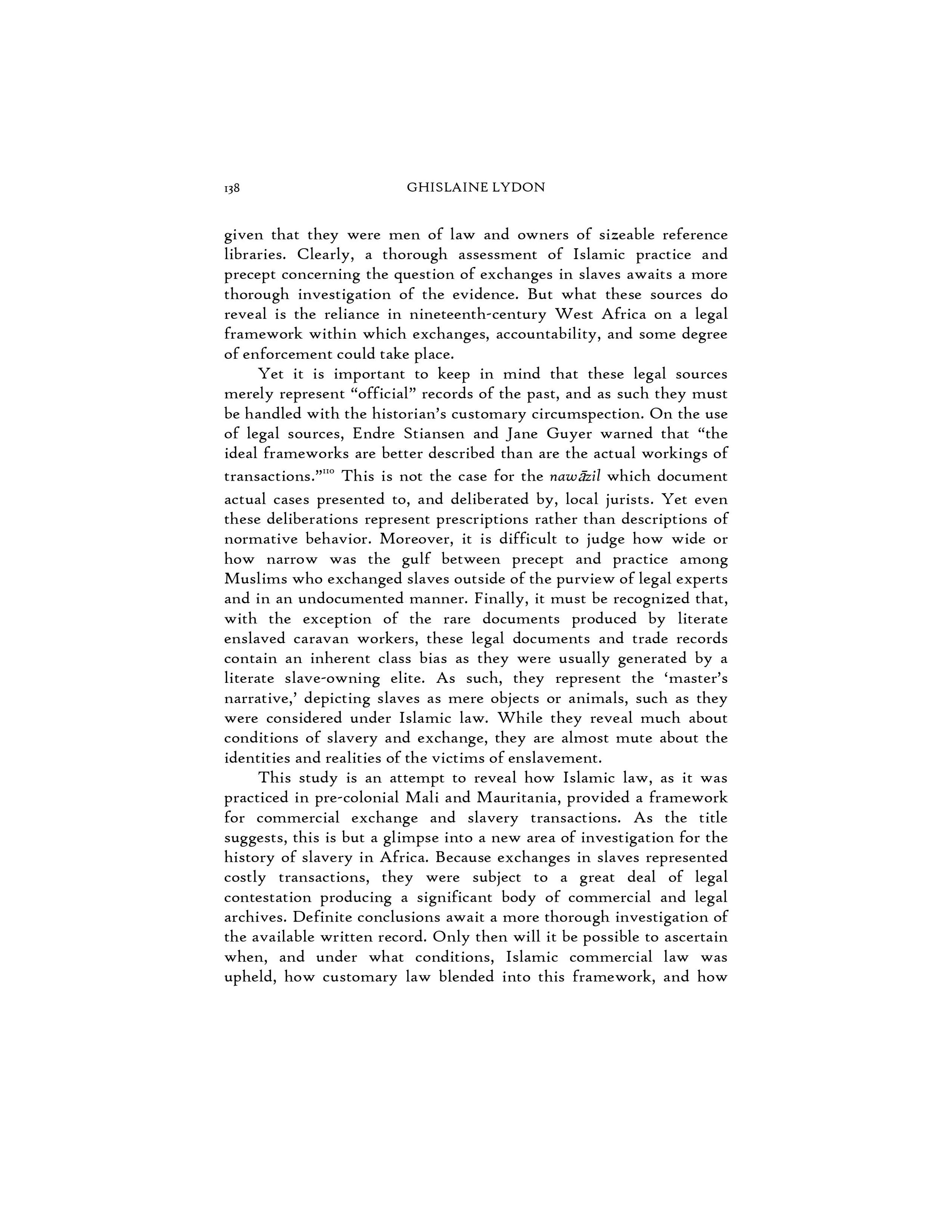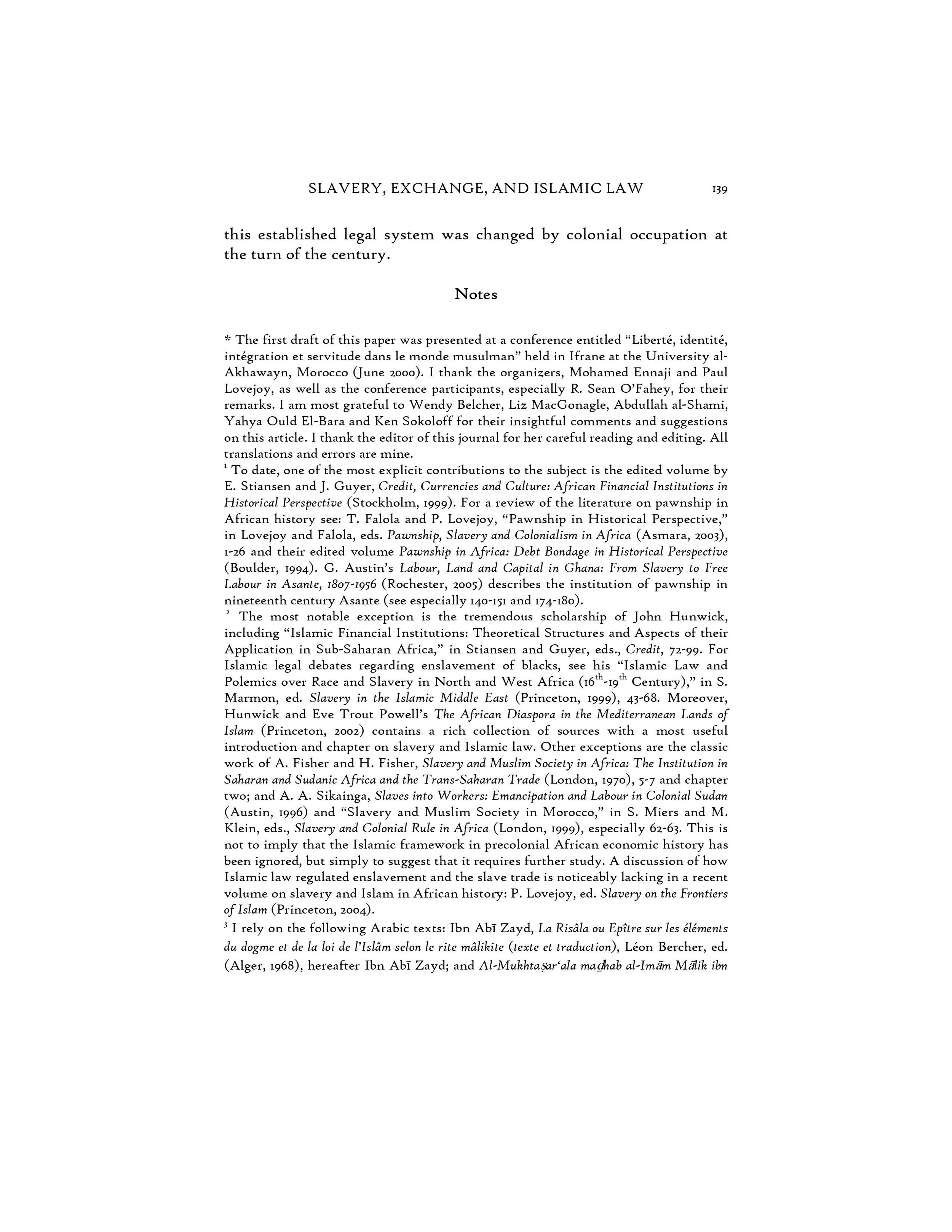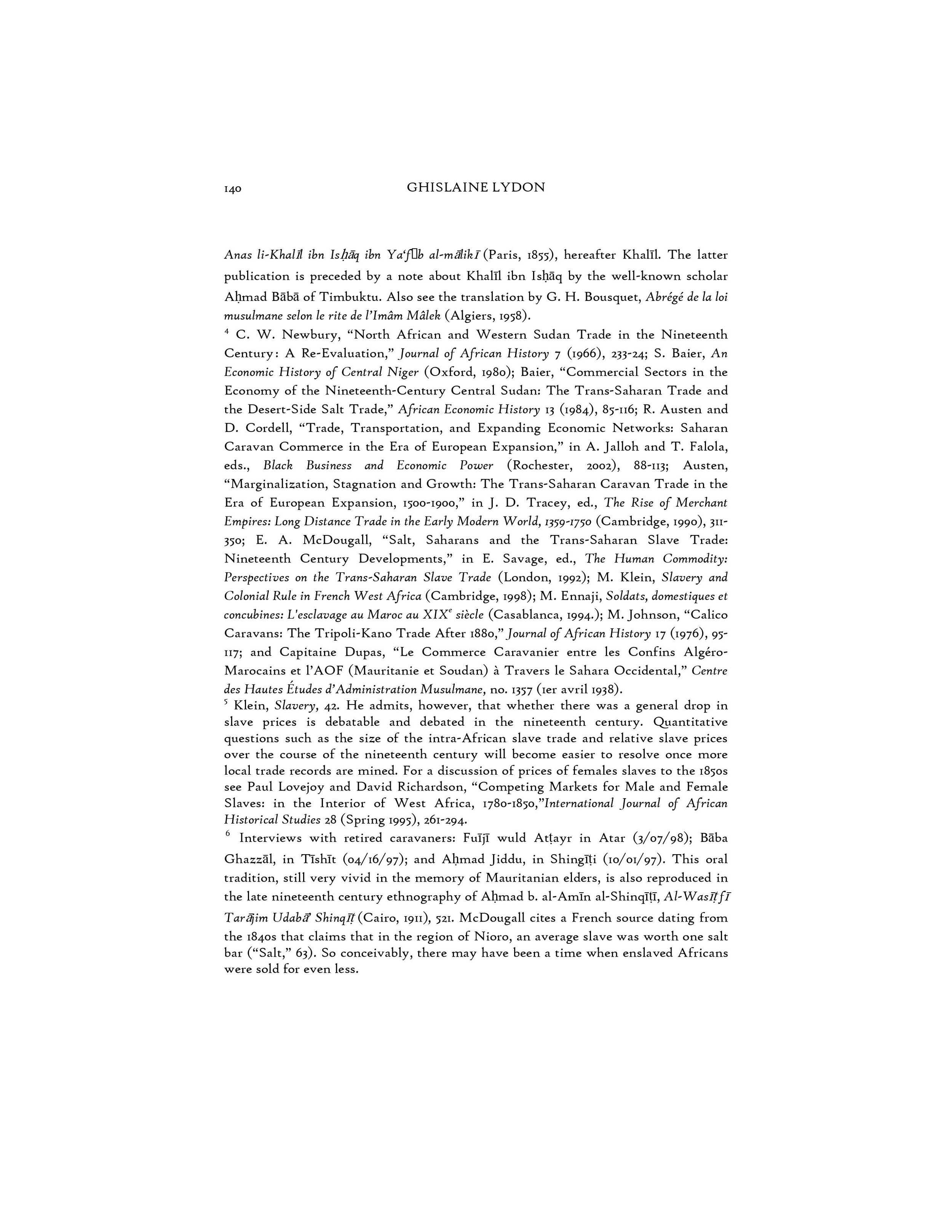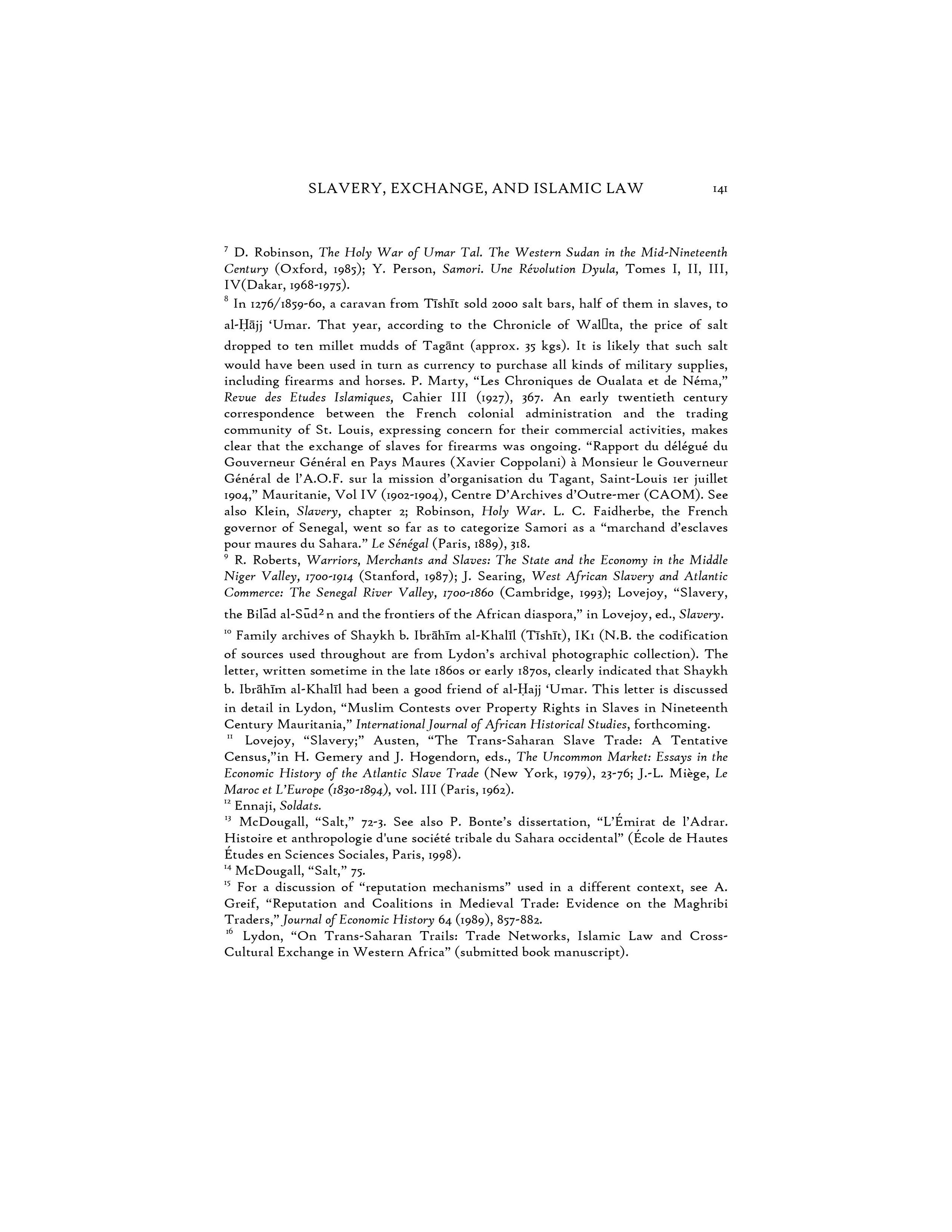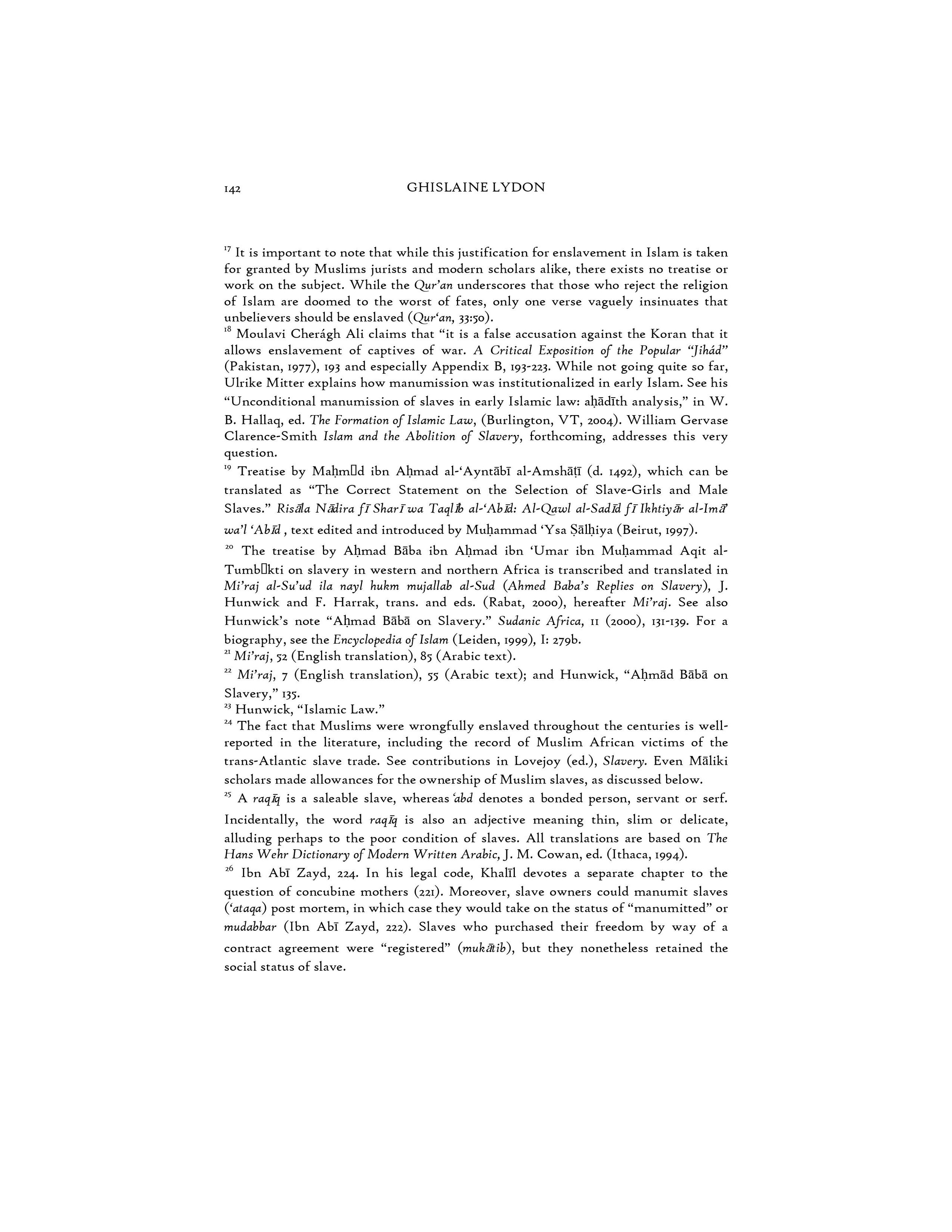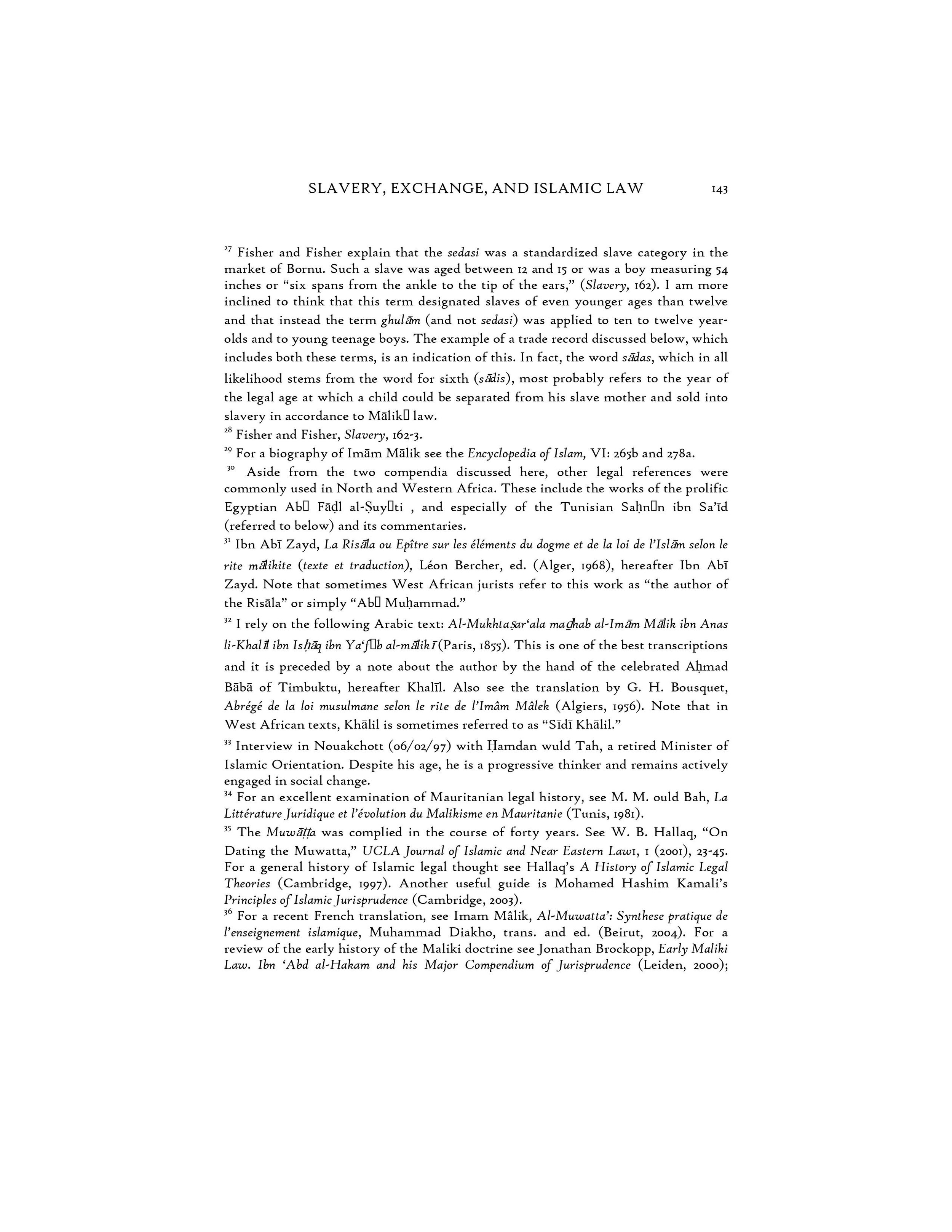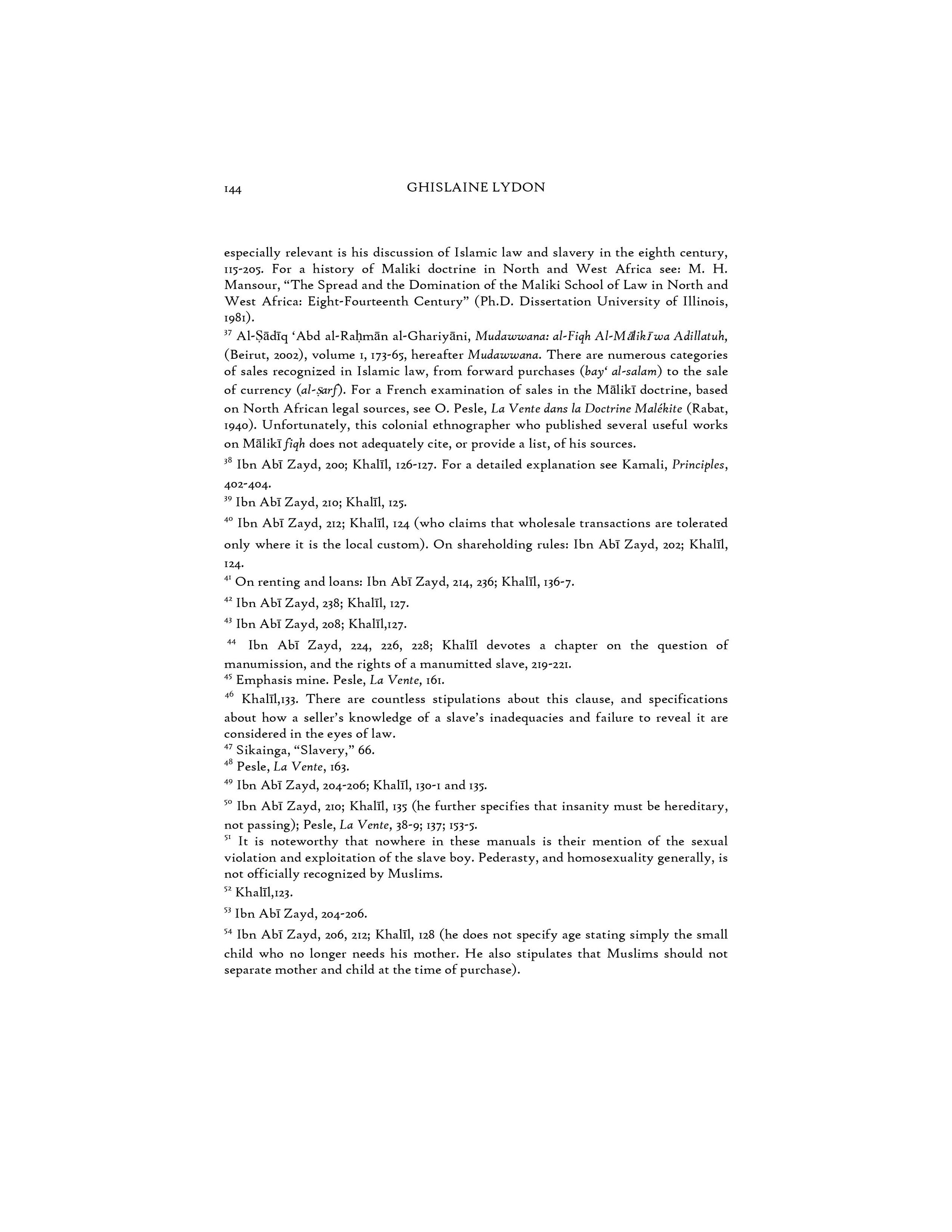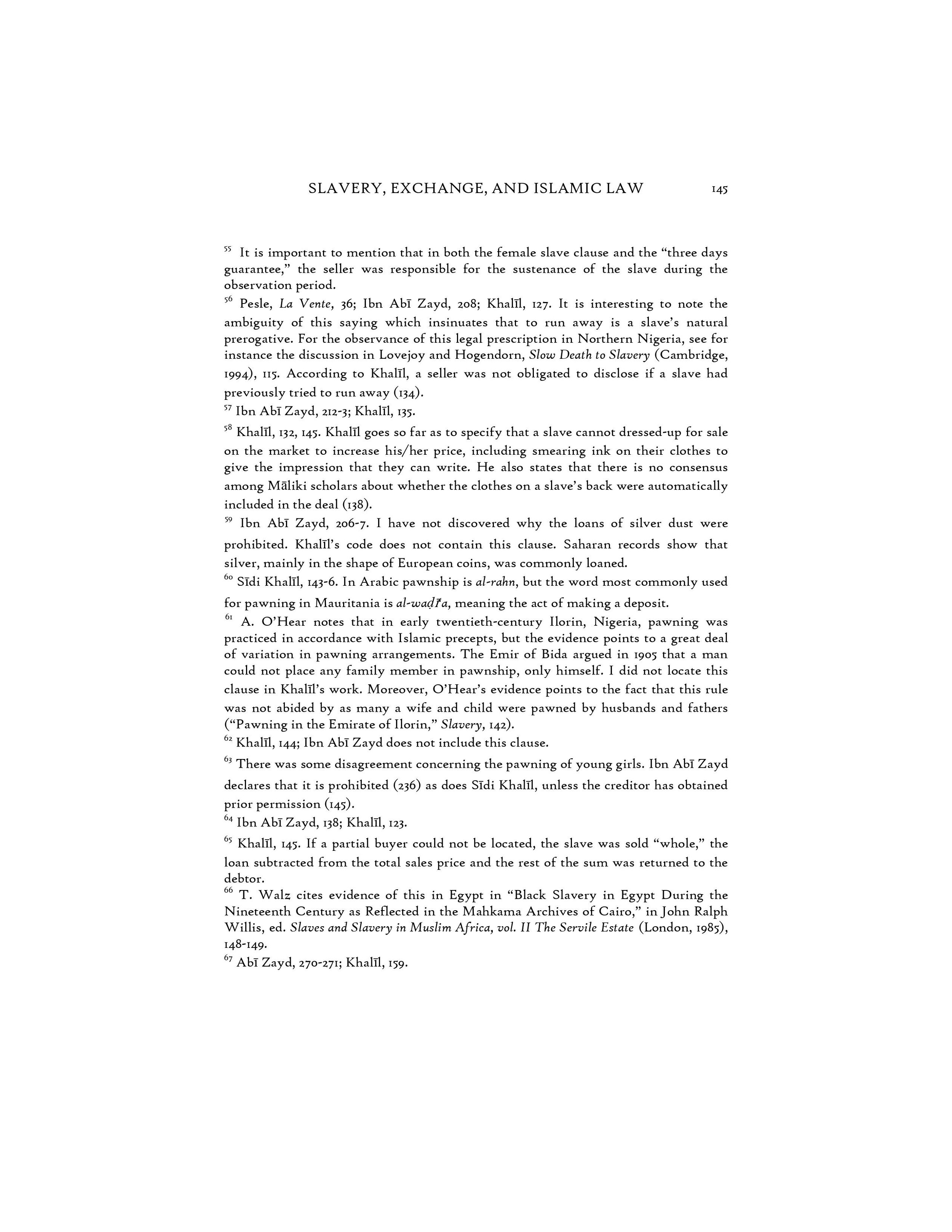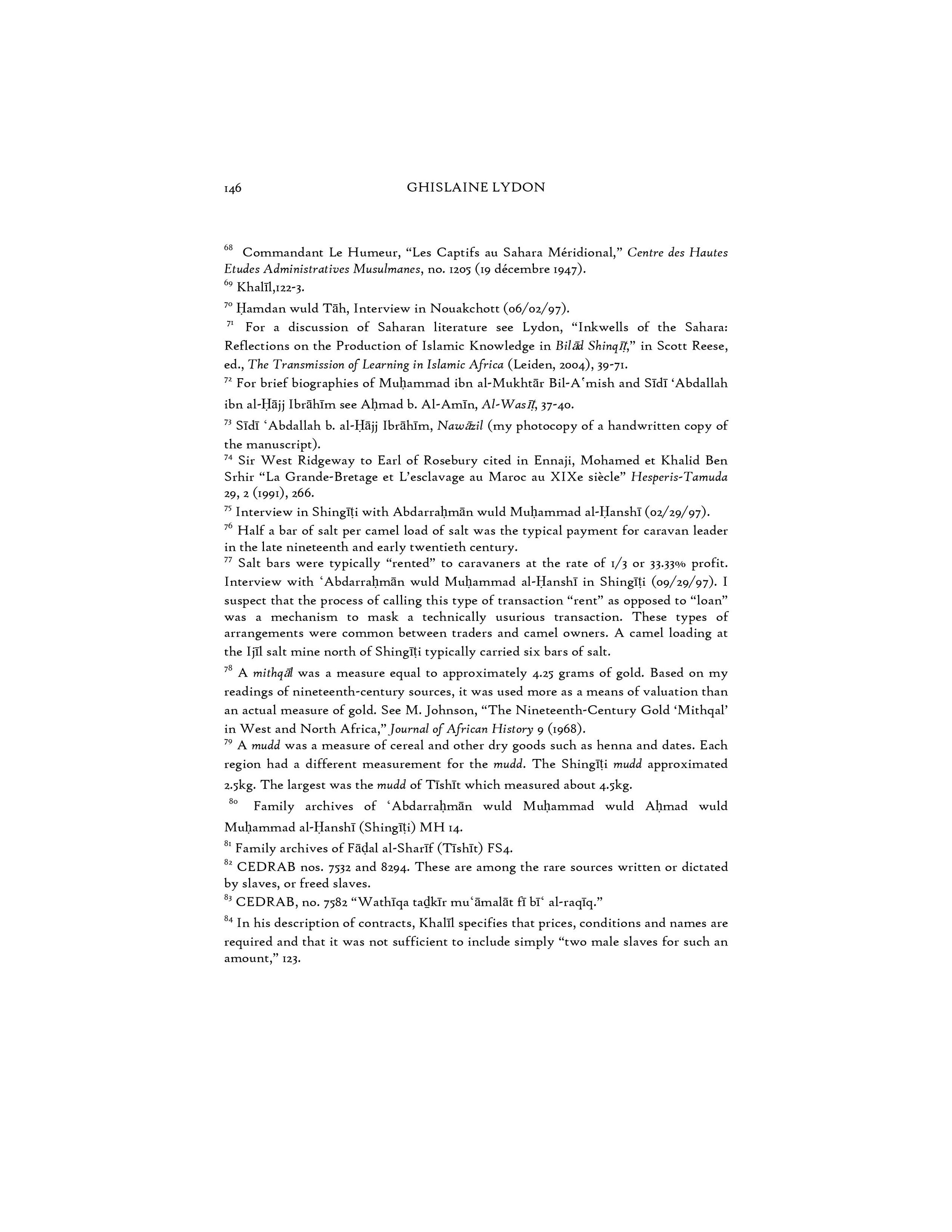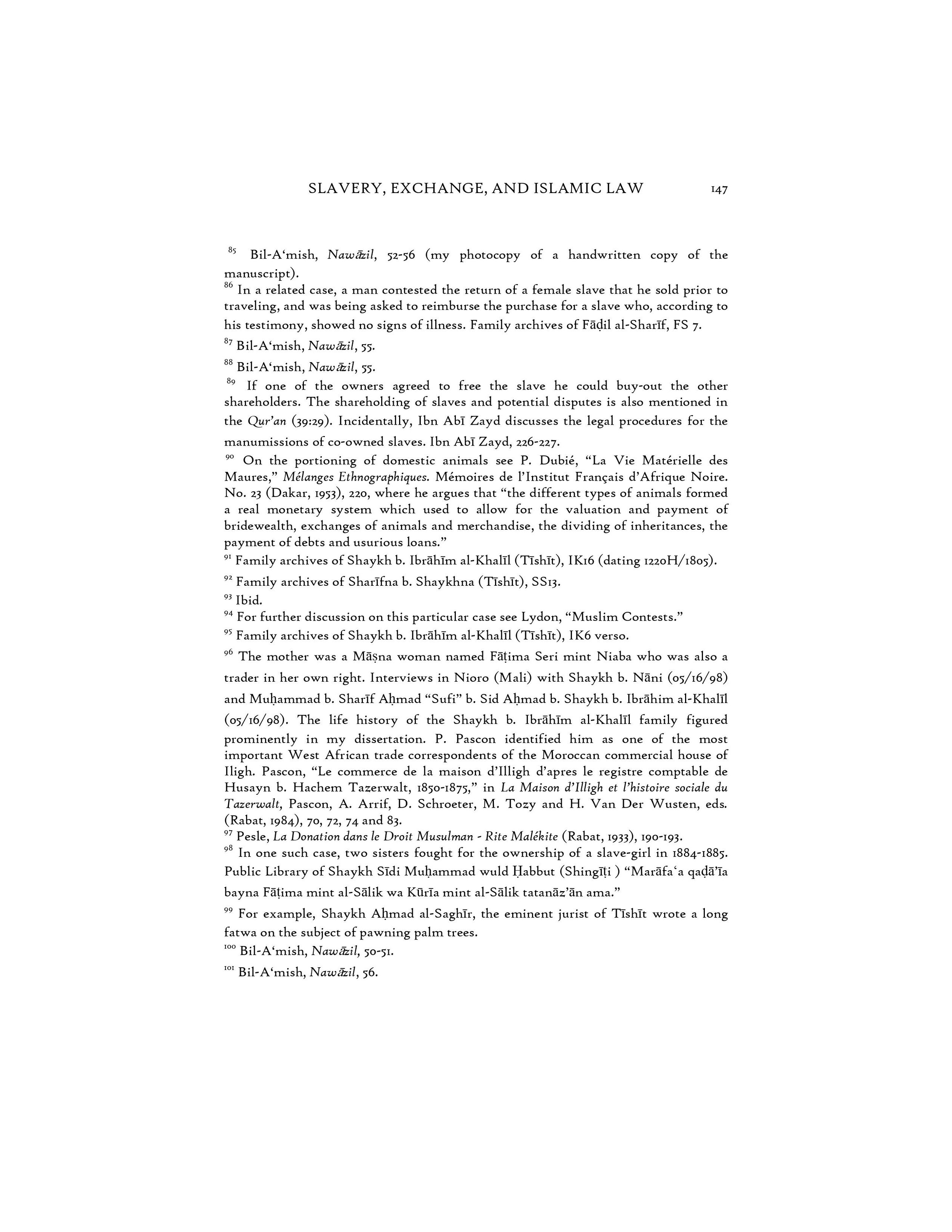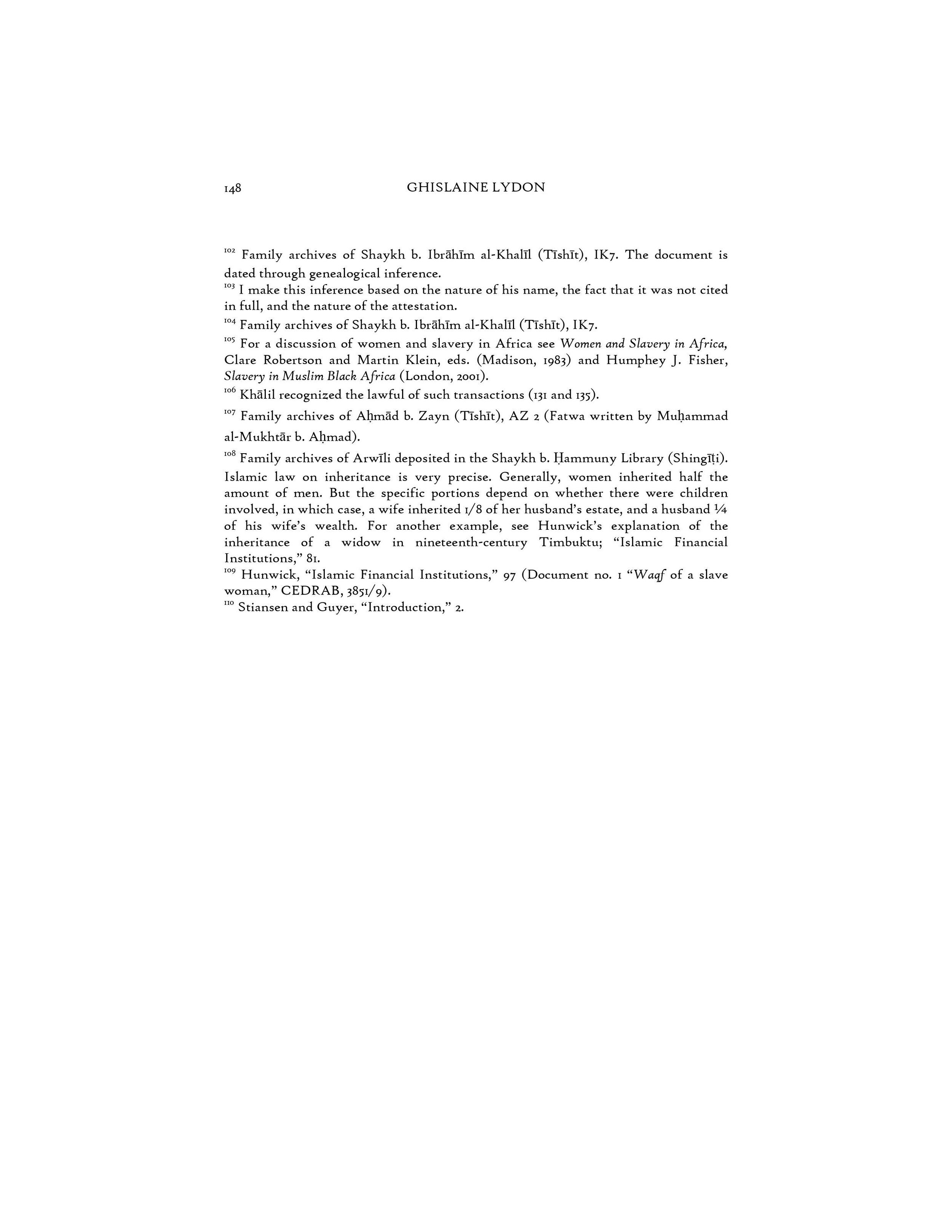“Again, the earliest sets of laws in ancient Mesopotamia popularly known as the laws of king Hamurabi (1780-1750 BC) supported as well as encouraged the practice of slavery. This set of Laws was given by the king of Babylon in 1750 BC and formed part of the Mohammedan’s and Roman-Syrian laws.101 This code of laws of king Hamurabi made clear provisions on the institution of slavery. It recommended acquisition of slaves through purchase abroad, captives in war and conversion of freemen degraded for debt or crime into slaves. A section of these rules also prescribed death as a penalty for “anyone who helped a slave to escape as well as for anyone who sheltered a fugitive. Despite this prohibition on manumission of slaves in the Hamurabic code of laws, one still finds a portion of the Koran where it recommends manumission for slaves as an act of piety. For example, chapter twenty-four of the Koran recommends liberation of slaves as follows: “As for those of your slaves which wish to buy their liberty, free them if you find in them any promise and bestow on them a part of the riches which Allah has given you” (Cf. Koran, 24:32). Itwas the message contained in this verse that motivated the third Caliph Ibn Othman (577-656) of Saudi Arabia to buy over two thousand slaves with the sole intention of granting them manumission afterwards. The Islamic law also prescribed that free Muslims should not be turned into slaves. Only infidels should be made slaves as a way of compelling them to embrace the Islamic faith. This was the fate of many African Christian societies of North Africa who refused to embrace Islam as their own religion. And in this sense, religion was made a weapon of enslavement against those Black Africans who did not belong to the Islamic religion. With this kind of justification of slavery in the Muslim world, the stage was now set for the restructuring of the African life and society in a manner that will suit the Muslim concept of slavery and governance of their new territories. Muslim merchants did not have any remorse of conscience in executing their assault on the African society. Having succeeded in bringing the Northern African states under their power and control, they made their way into the Eastern and Western parts of Africa in search of Black slaves to be sold into the Mediterranean regions and to Europe as well as to expand their territorial stronghold in Africa. And with the help of the Northern African states, it did not take the Arab-Muslims much to invade and subject the large kingdoms of Mali (Timbuktu), Angola and Songhai under their exploitative control. Even the powerful Christian kingdom of Ethiopia in the East, which had no single Muslim before the holy war was waged against it in 1520 succumbed to the Islamic power. Those turned into captives were sold as slaves into the regions across the Red sea as well as many Christians who resisted these Muslim incursions.
In their bid to make a maximum profit from this trade, the Arab-Muslims ensured that they had a strict monopoly and control of the Black African society and markets so that their European merchants will not intrude into West Africa to have a direct trade link with their Black African counterparts. To achieve this motive, they established six trade routes for a free flow export of captured Black Africans as slaves to Arabia, the Red sea and the Indian Ocean regions. Paul Lovejoy explains these routes as follows: the first went north from ancient Ghana to Morocco, a second stretched north from Timbuktu (Mali) to Tuwat (Algeria), a third passed from the Niger valley and the Hausa towns through the Massif to Ghat and Ghadames, a fourth travelled north from Lake Chad to Murzuk in Libya, a fifth reached north from Dafur in the eastern Sudan to the Nile valley at Assiout and a sixth passed north from the confluence of the Blue and the white Nile to Egypt. With these trade routes on ground, the next step taken was to create some African middlemen to control the caravan routes across the Sahara desert. The group of men who won the favours of the Arab-Muslim merchants were mainly from the Berbers (Libyans) called the “Tuaregs” who were dwellers in the regions closer to the desert. They mounted control posts on the various caravan routes across the desert and collected tolls from the owners of the caravan carrying the Black African slaves into Arabia and the regions of the Mediterranean coast. In order to fulfil their obligation in capturing slaves for the Muslim merchants, they were in the habit of mounting incessant slave raids on the settled communities of West Africa south of the Sahara, thereby kidnapping men and women from Songhai, Mali, Bornu and Guinea whom they sold to the Arab Muslim world. According to Paul Lovejoy, the reason for these attacks was that these regions “were more exposed to raids from desert nomads (Tuaregs), whose use of camels gave them the advantage of strategic surprise.” In the tenth century, the Arab Muslims established a slave commerce between the Christian merchants of Europe represented by the Normans and the Muslims of the Mediterranean coast. But these merchants from Europe were not allowed to establish direct business links with the Black Africans living in the hinterland regions. However, their needs were supplied by the Arab middlemen positioned at the various Arab slave ports such as the ones in Cadiz, Timbuktu and Sijilmasa (southern Morocco) who had direct contact with the West African products such as slaves, gold, ivory, ebony, dyed goat skins and Malaguetta peppers. And in return for these West African products, the European merchants brought with them products such as glass beads, weapons, cutlasses and woollen goods.” The nature of this trade is revealed in the kind of slaves demanded for its propagation and maintenance. They were mainly women, children, some men and Eunuchs. But women and Eunuchs were always on higher demand than the men, and their prices were also higher than those of the men. Confirming this, Paul Lovejoy said: “Muslims too wanted women, not men as is evident in the higher prices for women in the Muslim trade.” The male children were trained for military as well as domestic services. Young girls were also given some domestic training but the prettiest among them were placed in MuslimHarems as concubines where they were used for sexual activities. Some of the slave girls worked in Muslim Courts as cooks both in the cities of Cordoba and in Baghdad. The adult males and the rest of the women among them were given menial as well as laborious duties. The Eunuchs were also highly rated in the Muslim world. They were used as administrators in the government as well as overseers of the Muslim Harems. In general, slaves played an important role in the Islamic world. They were not often used for productive services but rather mainly for domestic services. . . . The demand for these slaves in the Mediterranean world was steady and was ever met with quick response by the Arab Muslims. A special demand was placed on the Black African slaves, whose services were greatly needed in the sugar and agricultural plantations established in Portugal, Spain and Italy for economic generation. That was why a good number of Black Africans sold into slavery by the North African Moors were seen in the Mediterranean coast of Spain in 1250 AD. They came mainly from the Atlantic Coast of Guinea, Benin, Ethiopia and Mali. The Muslim merchants had great interest in Black Africans and would always want to have them in a larger number as slaves for their household. The Black African male slaves were considered a good asset for military conquests and protection in the Arabic world. In order to respect the Islamic rule that Muslims should not be enslaved and at the same time to meet up with this demand for Black African slaves, the Arab Muslims organised some political strategy in the governance of many African societies under their control. They made sure that most African leaders were only those with Islamic aristocratic ancestry. Political appointments were restricted only to those who were Muslims and those who could identify themselves on ethnic grounds. That was why officials and merchants in all the northern and eastern African societies who took active part in the organisation and propagation of the trade in Africa were from the Muslim extractions. Their only option was to regard all the West African societies who resisted the Islamic expansion and rule as enemies of Islam and made them targets for slave raids and conquests.112 As a result of this pressure, some West African societies such as Mali, Ghana, Bornu, Kano, Sennar, Songhai and Adal succumbed to the Islamic influence in the thirteenth century and were forced to participate in the slave trade. They embraced the Islamic concept and legalisation of slavery and dropped the traditional concept of slavery prevalent in the West African society before the advent of Islam.113 This newly embraced concept of slavery as well as its acceptance as a legalised trading activity became a fire brand for a speedy spread of the slave trade among the societies in West Africa. Incessant and endless wars, slave raids and kidnapping of non-Muslims carried out in these West African societies became the order of the day. Lovejoy lent credence to this, when he said: “This legalism is instructive of the process by which slavery spread in the Savannah regions of Africa. For those who accepted a Muslim interpretation, enslavement was a legitimate activity, war was a normal relationship between Muslims and non-Muslims who did not accept their subjugation.”114 This led to the creation of a society that was replete with slaves. For instance, just a slave-raid conducted by the Muslims from Bornu against Kanem in the northern part of Lake Chad in the later part of the thirteenth century “netted a thousand females and two thousand male slaves who were divided among the soldiers. . . . “The East Africa accounted for a traffic in the order of 1000 slaves per year in the period from 800 AD to 1600 AD, the Red sea ports probably handled something like 2000 slaves per year in the same period, while the six main routes across the Sahara averaged from 3000 to 8000 per year.”
- From: The Popes, the Catholic Church and the Transatlantic Enslavement of Black Africans 1418-1839, Pius Onyemechi Adiele
****************************************************************************************************
The Balanta resistance and refusal to engage in slavery and slave trading by utilizing b’kindeu (ransoming captives back to their family) is well documented. Concerning slavery in West Africa at this time, academics and scholars of all persuasion are saying the same thing:
1) West African Societies, and particularly Islamic ones, developed their "empires" on the back of slavery (just like the Romans and Americans);
2) this is a neglected theme in the history of the Islamic world - "there is a gap because, among other reasons, scholars have not pursued the efforts of those who pioneered the history of plantations in Muslim societies."
One reason for this gap is due to the conspiracy of Griots from Mali to suppress the history. Consider this from Nubia Kai, discussing in her new book, Kuma Malinke Historiography; Sundiata Keita to Almamy Samori Toure, the first and last leaders of the Mali Empire from the 13th through the 15th centuries:
"Sundiata, the founder of the first and first emperor of Mali overcame a debilitating illness during his youth. He evaded the attempted murder initiated by his father's first wife Sassouma Beret, went into exile for several years with his mother Sogolon Conde and finally vanquished the despot [foreign name spoken] who had ruthlessly conquered and subjected the Manden kingdoms. Under his rule, the Manden kingdoms were reorganized into the Great Empire of Mali. He restored peace, order, justice and autonomy to the Mandinka kings and established alliances and solidarity with neighboring nations who were installed in the empire. [Sundiata's] greatest achievement which until recently was guarded in secrecy by a consensus of Mandinka griots was his abolition of slavery and the slave trade. His numerous conquests in West Africa were launched in order to enforce the oath of the Manden. The Edict officially banning slavery and slave trade in the empire.
UNFORTUNATELY, THE SLAVE TRADE AND SLAVERY WAS RESUMED 20 YEARS AFTER HIS DEATH AND APPARENTLY THE NATIONAL SHAME OF THE BREAKING OF THE OATH COMPELLED THE GRIOTS TO CENSURE THIS SIGNIFICANT EVENT FROM THE ANNALS OF MALI'S OFFICIAL HISTORY, YET THIS EFFACEMENT WAS PUBLIC NOT PRIVATE AND INITIATED GRIOTS, THE [FOREIGN WORD SPOKEN] WERE TAUGHT THE HISTORY BUT HAD TO SWEAR NEVER TO REVEAL IT.
[Foreign name spoken] who was the chief griot of Mali in the 1970s and 80s griot [foreign name spoken], made the decision to break the vow of silence and divulge this hidden history to a Malian historian, a modern Mali historian [foreign name spoken]. [Foreign name spoken] collected and published [foreign name spoken] [foreign words spoken]. Excuse my French for those of you who know the language right and I want to show you and talk about the oath of the Manden or it's also called the Manden Charter in the PowerPoint but I'm going to come back to that. . . . .Now this Manden Charter is as I said before, was a charter or an oath that was constructed at the beginning of the formation of the Mali Empire and with the information that came out, and this information came out in the 1980s, the secret history was revealed through [foreign name spoken].
NOW SCHOLARS ARE TRYING TO LOOK, THEY HAVE TO KIND OF LOOK AGAIN AT THE WHOLE HISTORY OF MALI BECAUSE INSTEAD OF SOME RULER CONTE WHO WAS THE ENEMY IN THE EPIC OF SUNDIATA KEITA, HE NOW BECOMES THE HERO OR IS A HERO BECAUSE HE WAS THE ONE WHO CAME UP WITH THE IDEA TO END SLAVERY IN THE MALI EMPIRE AND WHAT HE DID HE TRIED TO CALL THE MANDINKA PEOPLE TO ARMS AGAINST [FOREIGN NAME SPOKEN] AND AGAINST THE MOOR'S [ASSUMED SPELLING] AND OTHER MANDINKA WHO WERE ALSO TRADING IN SLAVES.
Now this is 300 years before the transatlantic slave trade and it was pretty bad even at that time and I'm not going to go into all the details but if you want to read [foreign name spoken] text that, again, where he's recording [foreign name spoken] you can get the text, but they have not been translated. They're still in French. Anyway, [inaudible] comes up with the idea and when the Mandinka refuse to go along with him and ending slavery because some of the major leaders in the Manden were slavers.
THEY WERE BIG SLAVERS AND SLAVE TRADERS, SO THEY REFUSED. SO, [FOREIGN NAME SPOKEN] THIS IS WHEN HE LAUNCHES HIS ATTACK. HE ATTACKS THE MANDINKA PEOPLE, KILLS 9 OF THE KINGS, IMPALES THEIR BODIES ON SPIKES, MAKES FURNITURE OUT OF THE SKINS OF HIS ENEMIES AND LITERALLY SELLS THE PEOPLE INTO SLAVERY. THAT WAS HIS RESPONSE WHEN THEY REFUSED TO END SLAVERY. THAT'S WHY IN THE SECRET HISTORY HE'S KNOWN AS A SACRED DESPOT. IT SOUNDS RATHER OXYMORONIC BUT HE'S CALLED A SACRED DESPOT BECAUSE THE IDEA TO END SLAVERY AND THE SLAVE TRADE WAS REALLY [FOREIGN NAME SPOKEN] IDEA.
So, finally and you probably know the story because the Epic of Sundiata has now become part of the literary canon now, you're reading in colleges almost everywhere. You know the story how he's away in exile because his step-mother is trying to kill him. He's away and the envoys are sent to get him and when comes back he goes into, he has this war with [foreign name spoken] and eventually vanquishes him and then he becomes the emperor. But what happens is, just before his mother passes away, his mother is Sogolon Conde who tells him, look they're going to ask you to be the emperor but before you accept the position of emperor I want you to abolish slavery and the slave trade in the Mali Empire forever and of course he agreed to do this and so this is what he did.
THIS IS WHY HE GOES ONTO THIS CONQUEST OF THE OUTLYING NATIONS LIKE THE JOLOF AND [FOREIGN NAME SPOKEN] AND OTHER PARTS AROUND MALI BECAUSE HE KNEW AS LONG IT CONTINUED IN THE OUTLYING AREAS IT WAS GOING TO INFILTRATE BACK INTO THE MANDEN PROPER. SO, HE CREATES AN EMPIRE THAT WAS SLAVE FREE, YOU KNOW, AN EMPIRE WHERE SLAVERY WAS FORBIDDEN AND WHERE THE TRADE WAS FORBIDDEN AND THIS IS HOW THE CHARTER GOES.
The hunters refers to it because Sundiata was a hunter. "The hunters declare all human life is one life. It is true that one life may appear to exist before another life but one life is not more ancient or more respectable than another life. “
HERE WE HAVE THE TRUTH, BUT FOR THE TWENTY YEARS DURING SUNDIATA’S REIGN, THE MALI EMPIRE WERE THE BIGGEST SLAVE TRADERS BEFORE AND AFTER.
The praise and honor that the kingdom of Mali receives by historians and ignorantly repeated by people today, especially during Black History Month, is based on the idea that such state superstructures are an indication of superiority when, in fact, our Balanta ancestors recognized that the states like Mali created inequality and violated the Great Belief, and thus were resisted. We do not view the Empire of Mali as a point of pride because it was oppressive and continuously tried to dominate and enslave Balanta and other people living in the area. Unfortunately, it was during this period that the people known as “Portuguese” arrived.
Today, scholars have identified Kano, Djenne, Timbuktu, and the western edge between Walata and Niani as the main slave markets in Mali.
This map shows the main slave markets in the territory of the Mali Empire.
SO THE NEXT WAVE OF RESEARCH IS TELLING THE STORY OF WHO ENSLAVED WHO, WHEN and WHY...
This is necessarily going to be a challenge for some people, especially those whose ancestral lineages/ethnicities were complicit as well as for Muslims. As I have previously stated,
“There's no debate among scholars that slavery and the slave trade took place in West Africa during the middle ages. If we are to learn from the mistakes of our past to build a UNITED AFRICA today and for the future, we must discuss these things and be HONEST about them. WHO ENSLAVED WHO, HOW THEY DID IT AND WHY THEY DID IT. Otherwise, petty ETHNIC TRIBALISM and systems that produce social castes and inequality will continue. If ethnic or religious pride causes you to deny, defend, or minimize the injustices of the past, THEN YOU ARE THE PROBLEM.”
Scholars are now re-reading original African sources such as The Epic of Sundiata, The Epic of Kelefaa Saane, the Ta'rikh al Fattash, and many others, with new frameworks and understanding in order to piece together the untold story of people written out of history, Consider this from the Kano Chronicle:
This early document, like many others, provides the early documented evidence that foreign invaders from the east and northeast came and waged war on the people already living there. This would include our Balanta ancestors.
THE WEST AFRICAN SLAVE PLANTATION
"There are many neglected themes in the history of the Islamic world. Few, however, are as neglected as the role of plantations in that history. Yet what bits of information we have on the subject tend to suggest that, contrary to popular belief, plantations were a vital factor not only in the consolidation of some Muslim states, but also in determining some of the ways in which these societies reacted and adjusted to the challenges that confronted them. At least, one can come to such a conclusion on the strength of the evidence provided in some of the works discussed below. Despite this literature, there is a gap because, among other reasons, scholars have not pursued the efforts of those who pioneered the history of plantations in Muslim societies. It is partly to fill this lacuna that the present study has been undertaken."
TRANSFORMATIONS IN SLAVERY: A HISTORY OF SLAVERY IN AFRICA (AFRICAN STUDIES) 3RD EDITION
"This history of African slavery from the fifteenth to the early twentieth centuries examines how indigenous African slavery developed within an international context. Paul E. Lovejoy discusses the medieval Islamic slave trade and the Atlantic trade as well as the enslavement process and the marketing of slaves."
Here, another researcher has come to the same conclusions as we have previously published:
1) in an early period starting around 500 AD, there was plenty of land, thus migration was the simplest solution for conflict resolution.
2) Metallurgy led to social stratification and exacerbated competition for resources (just as it did THE FIRST TIME IN THE NEKHEN CONFEDERATION with the Mesinu);
3) "warlords" developed slavery for power; some societies resisted this pressure in an attempt to remain/retain their "pure" egalitarian societies.
Now, WHO WERE THESE AFRICAN COLONIZERS and WARLORDS who created the West African Empires??? We have already identified some of them in Mali. See article:
MANSA MUSA WERE IMPERIALIST SLAVE TRADERS: REVISITING AFRICAN HISTORY FROM THE POINT OF VIEW OF THE PEOPLE WHO WERE OPPRESSED
For more background, read the article below:
Slavery, Exchange and Islamic Law: A Glimpse From The Archives of Mali and Mauritania
Remember, our Balanta ancestors migrated straight through from Lake Chad to Guinea Bissau, passing through the territory and history of several people and “Empires”. All of this is detailed in the book, Balanta B’urassa, My Sons: Those Who Resist Remain, Volume II. Balanta Elder Estanislau Correia Landim is quoted by Walter Hawthorne in Strategies of the Decentralized, (from the book Fighting The Slave Trade: West African Strategies by Sylviane A. Diouf):,
“The origin of the Balanta was in Mali. For reasons involving Balanta thefts, Malianos revolted against the Balanta. For this reason, Balanta left there. That is, some Balanta were stealing some things. When a thief was discovered, he resolved to kill the person who had discovered him. For this reason, Malianos chased after the Balanta. . . . When the Balanta left Mali, they went to Nhacra and then to Mansoa.”
THIS NARRATIVE THAT BALANTA PEOPLE WERE CATTLE THIEVES, HOWEVER, IS NOT ACCURATE. Balanta people were NOT cattle thieves. Domingos Broksas in the video below explains that in reality, when the Mandinka raided the Balanta villages, the Balanta would flee, leaving their cattle behind. Later, they would go and retrieve their cattle. This is called “Reparations”, not theft.

